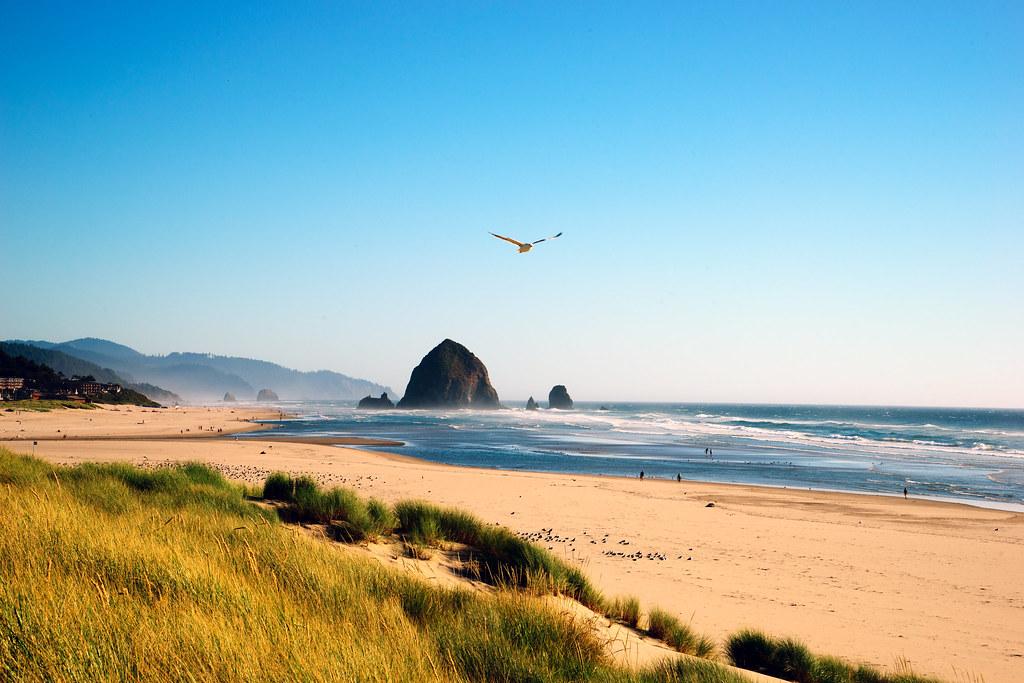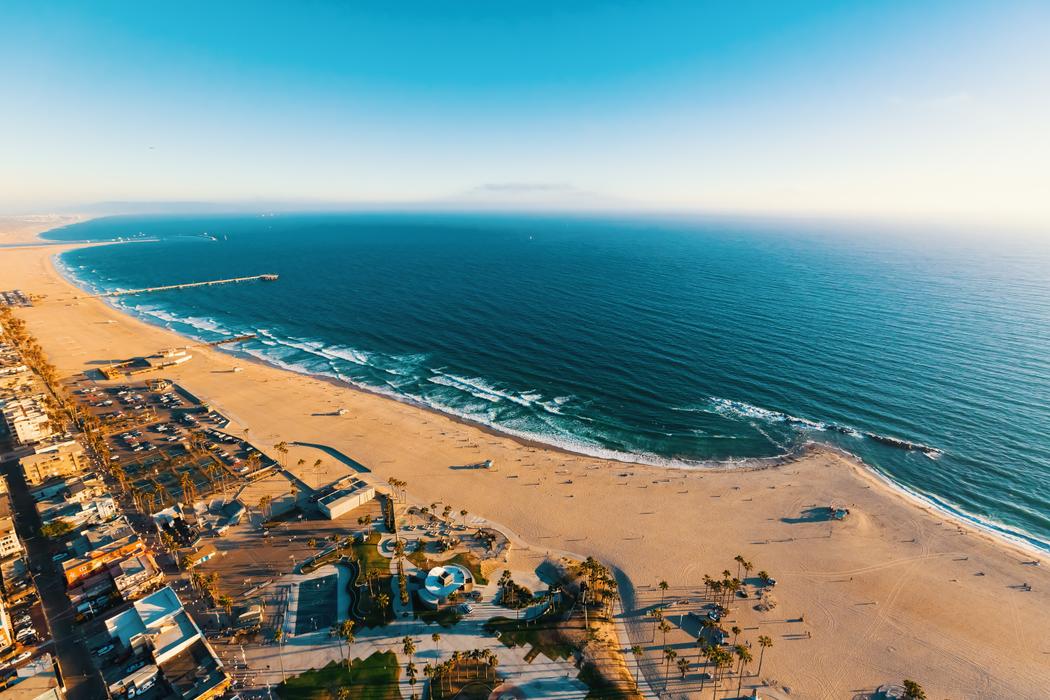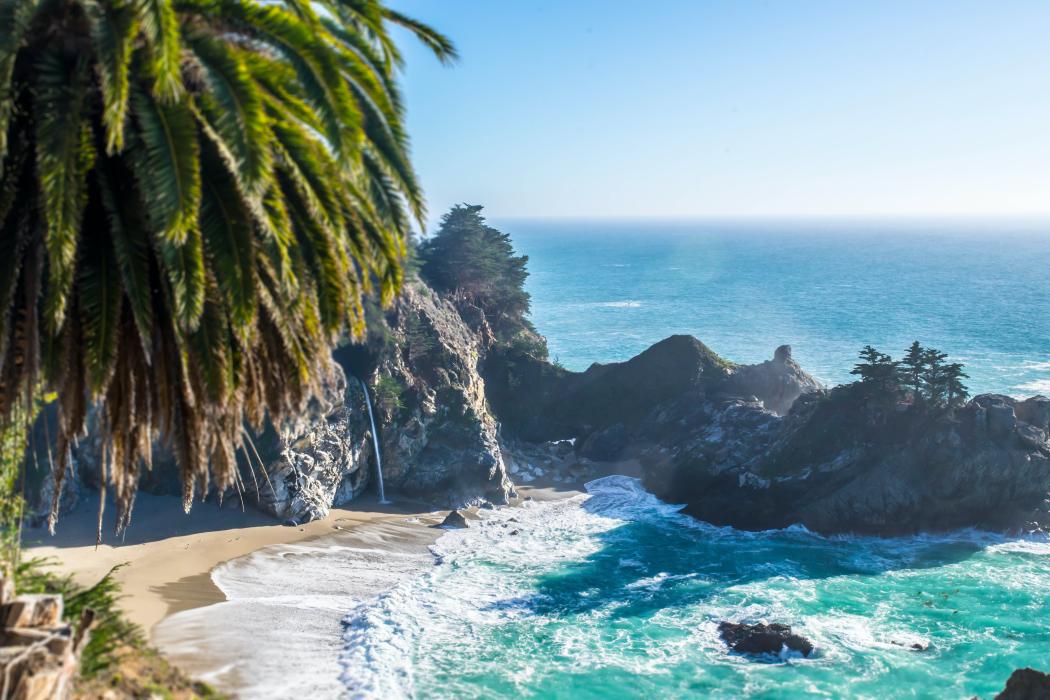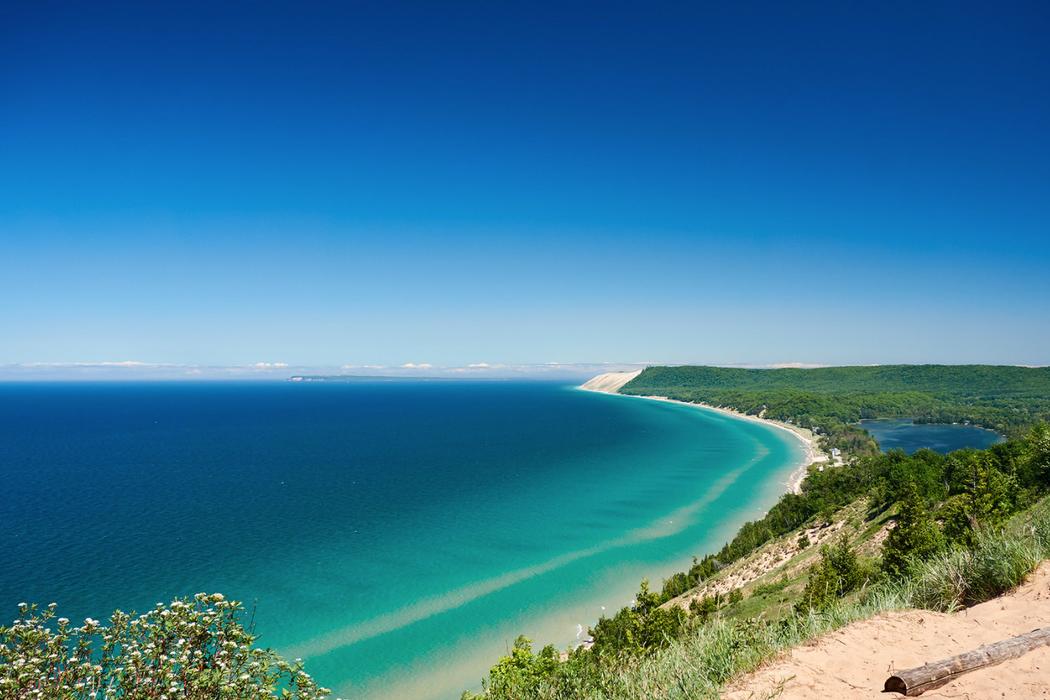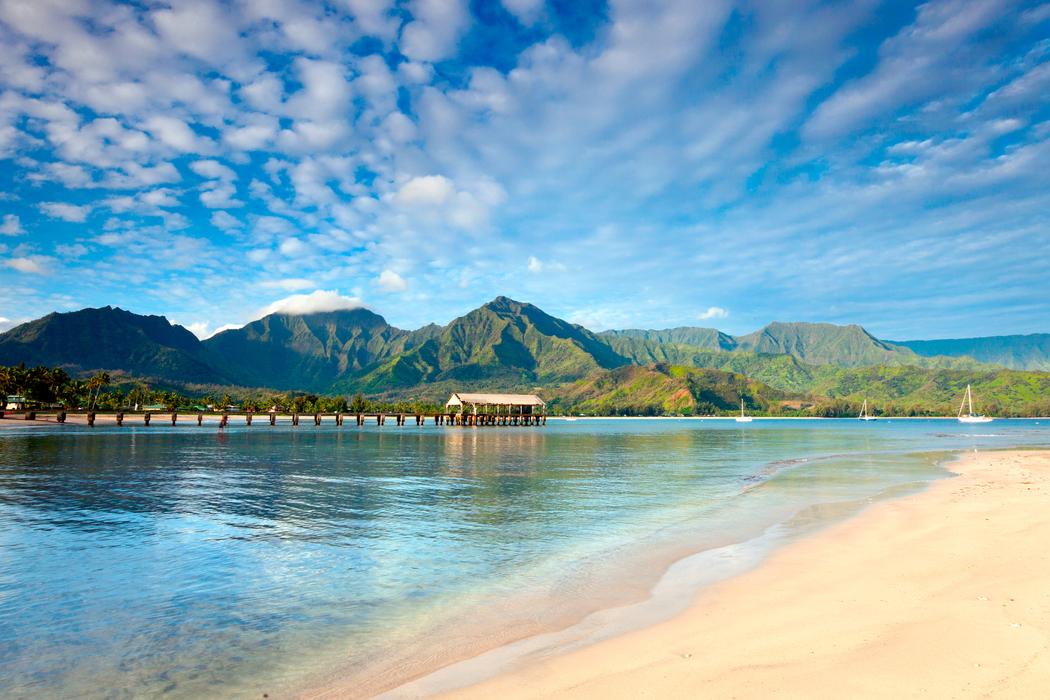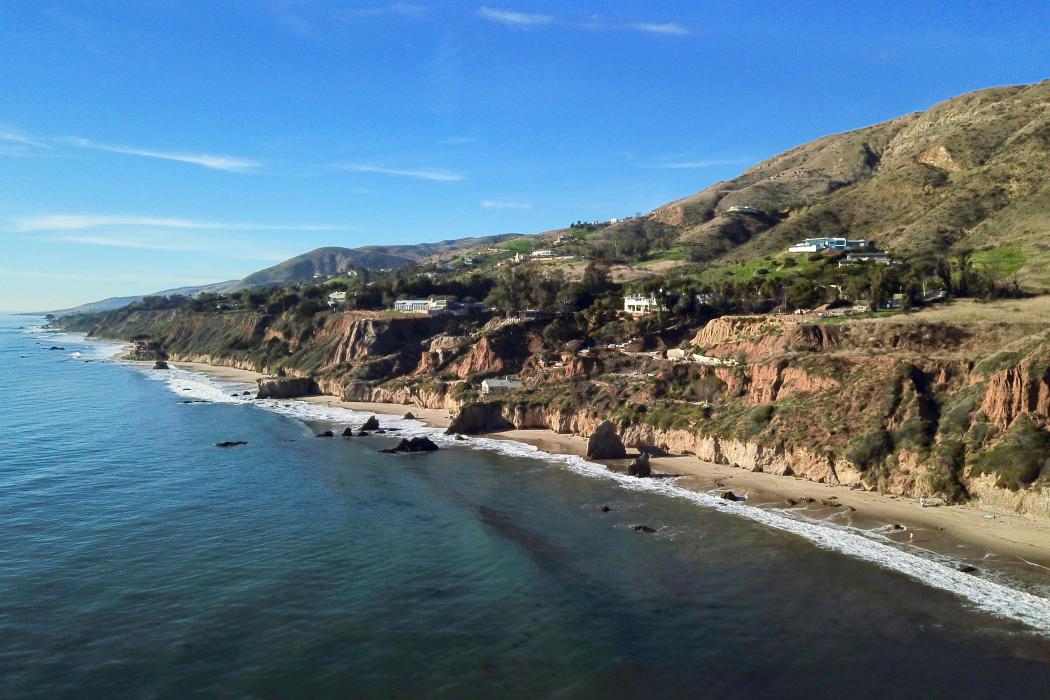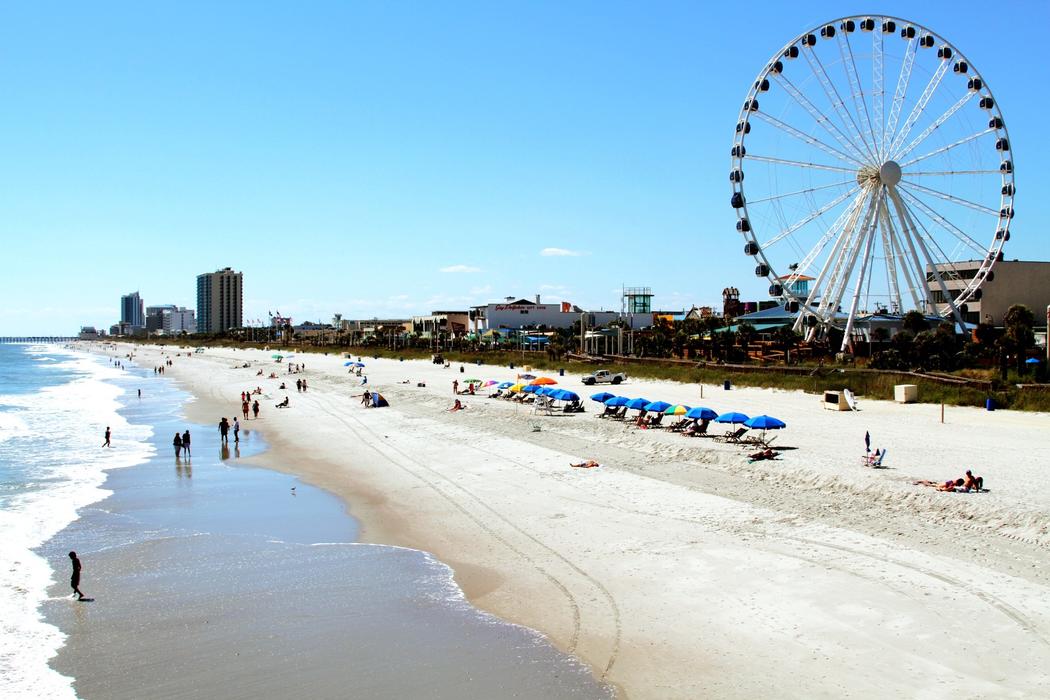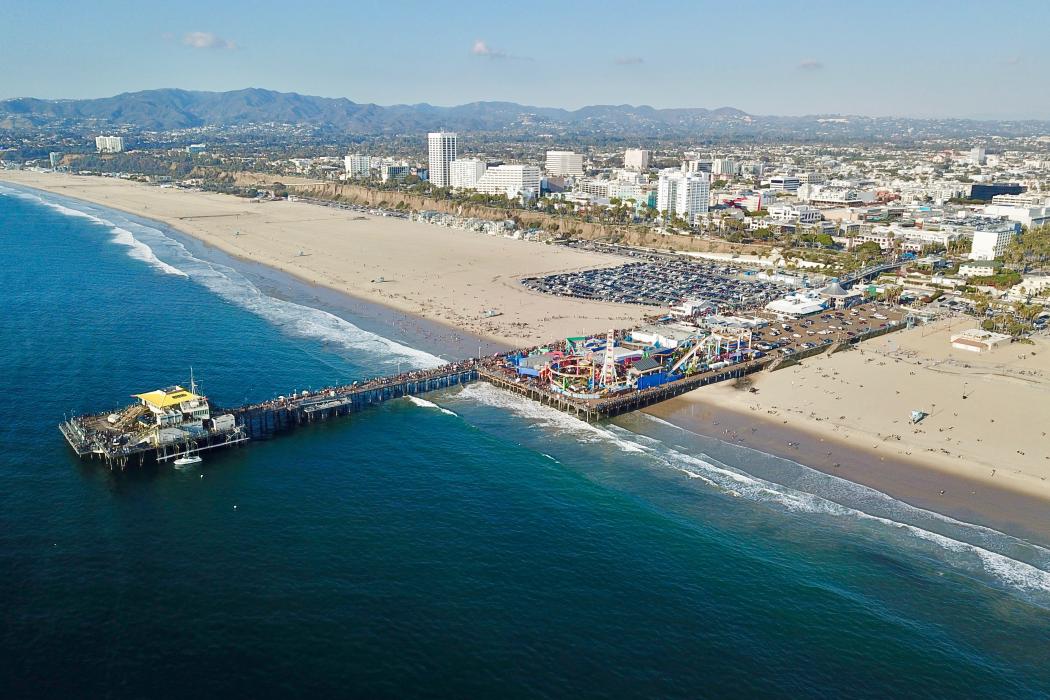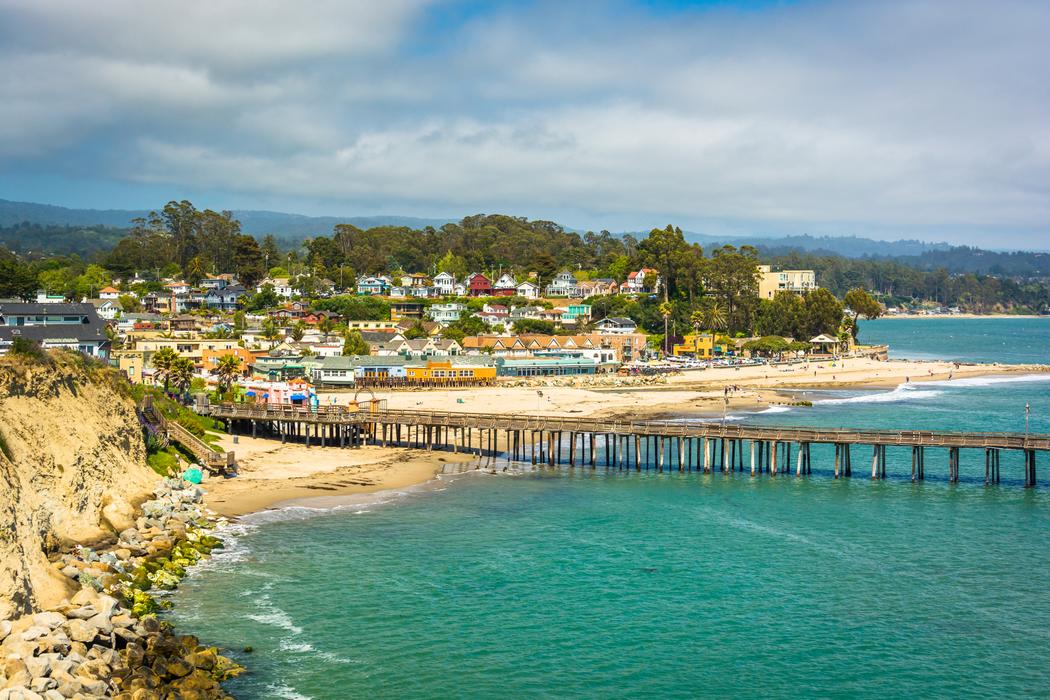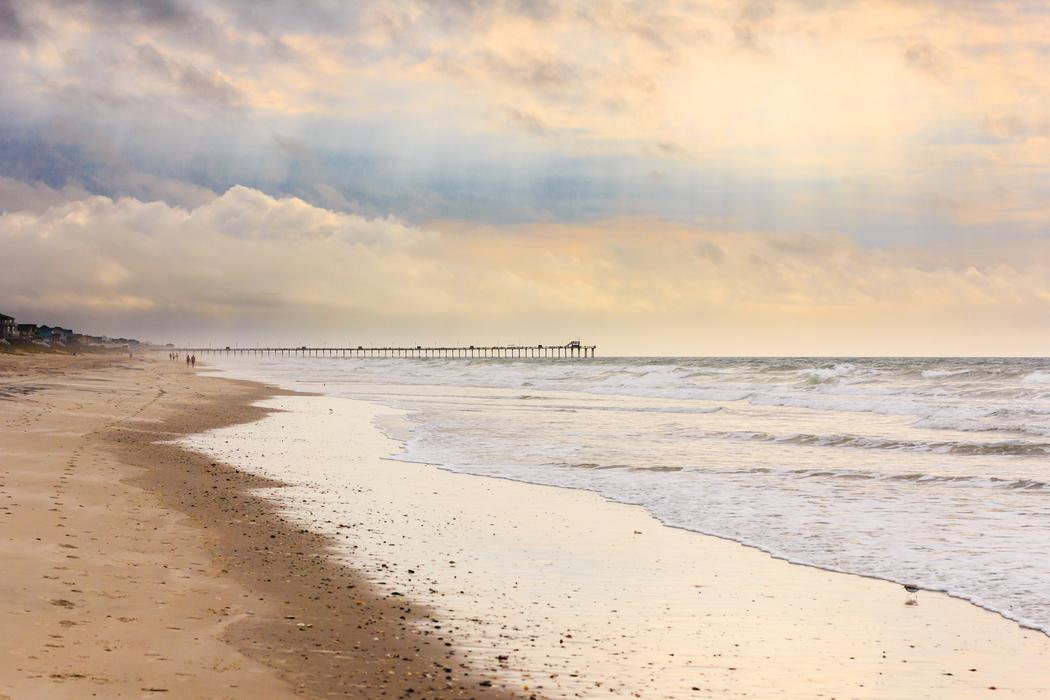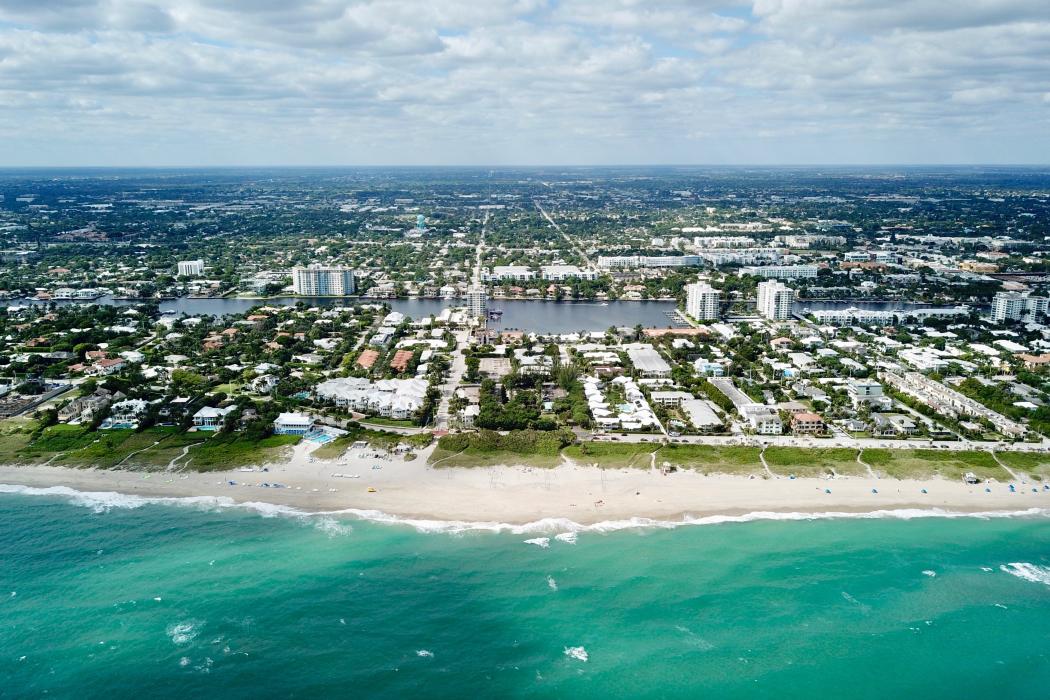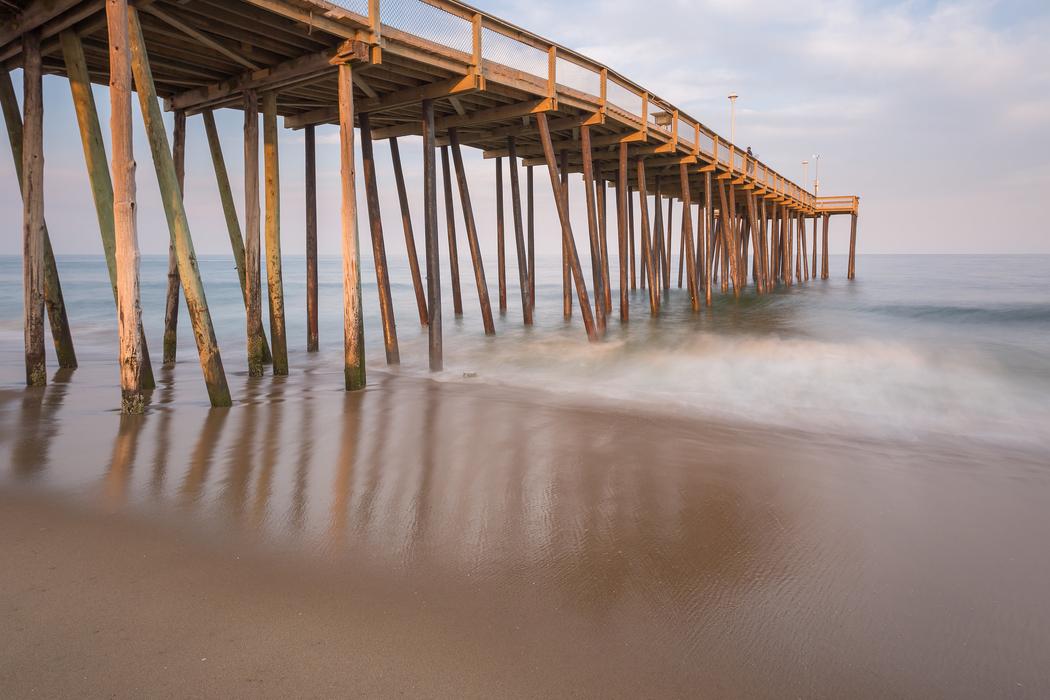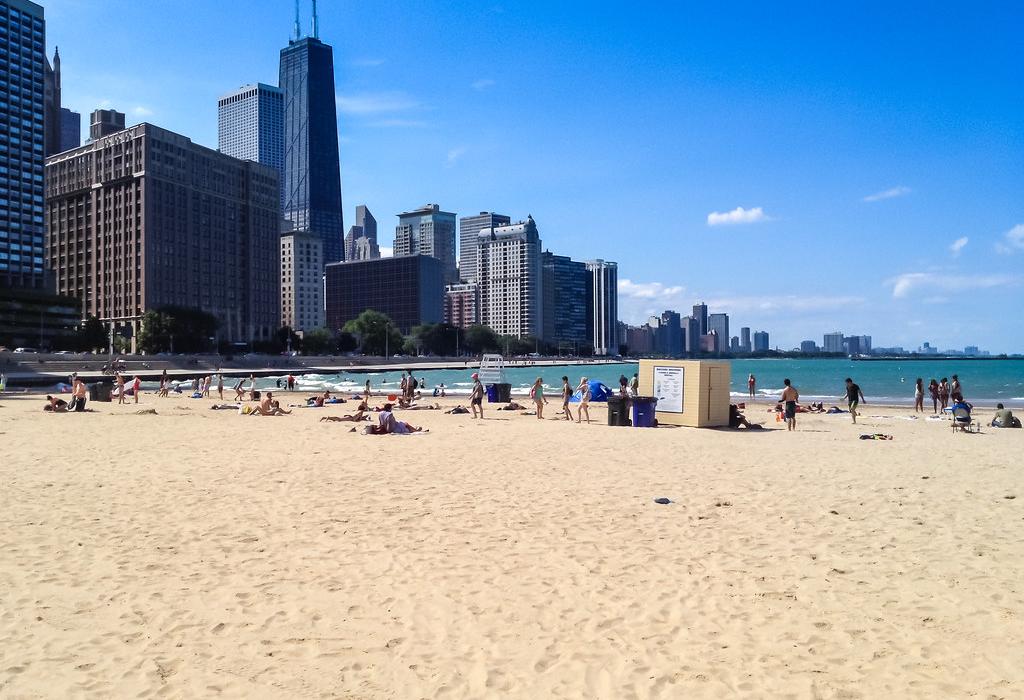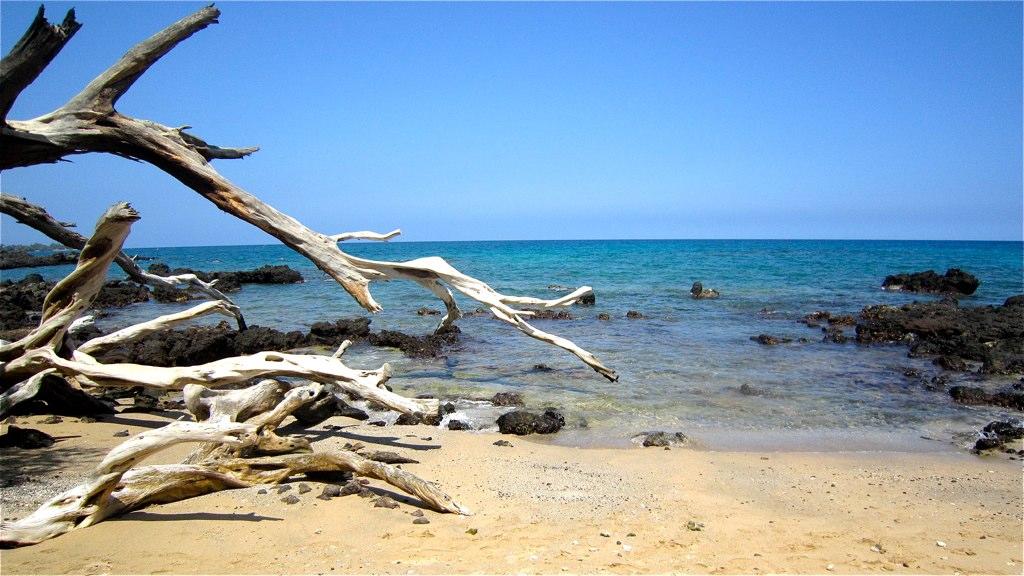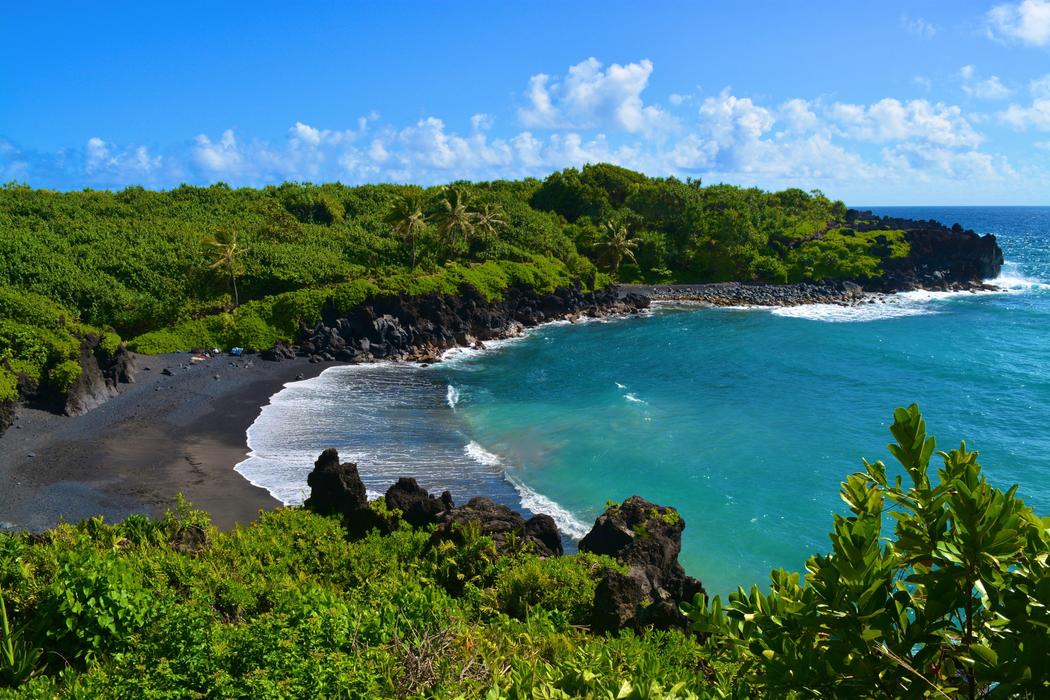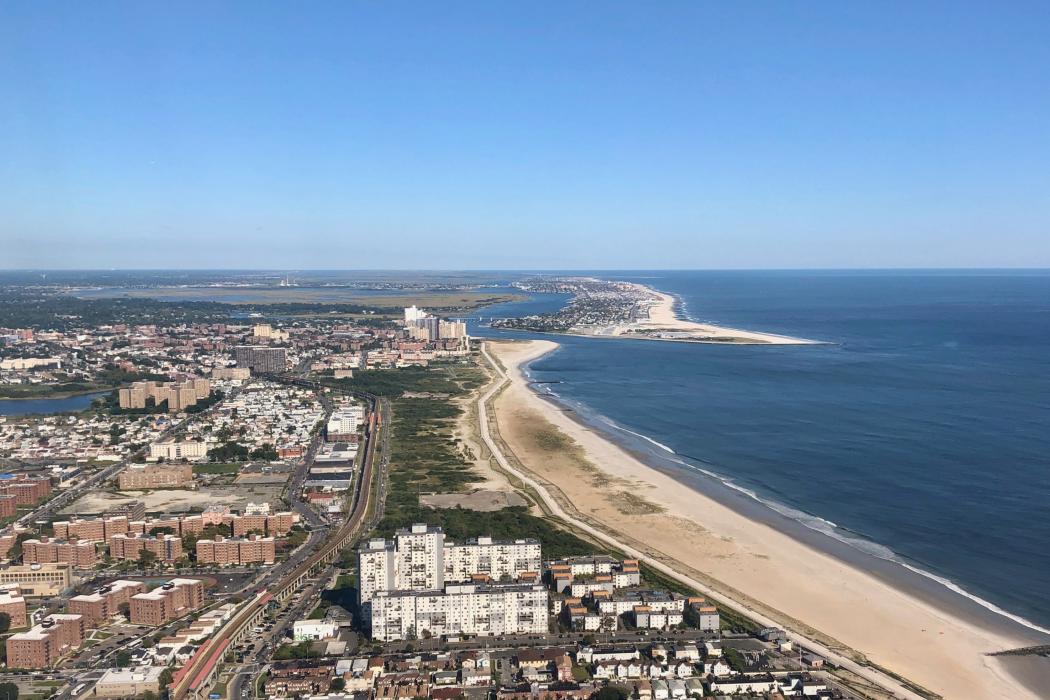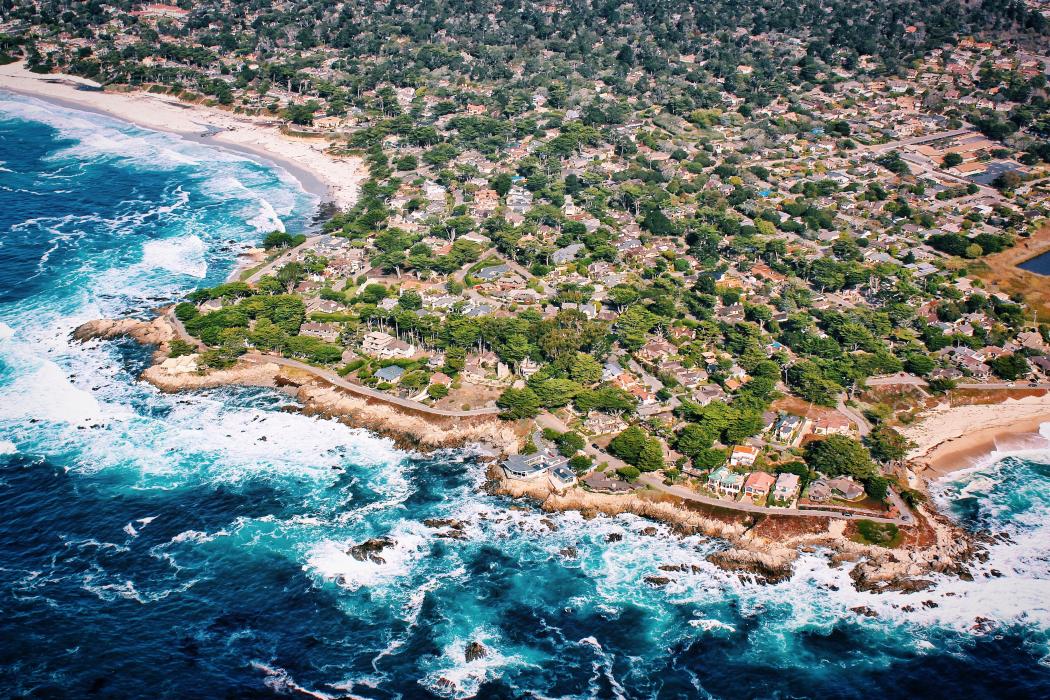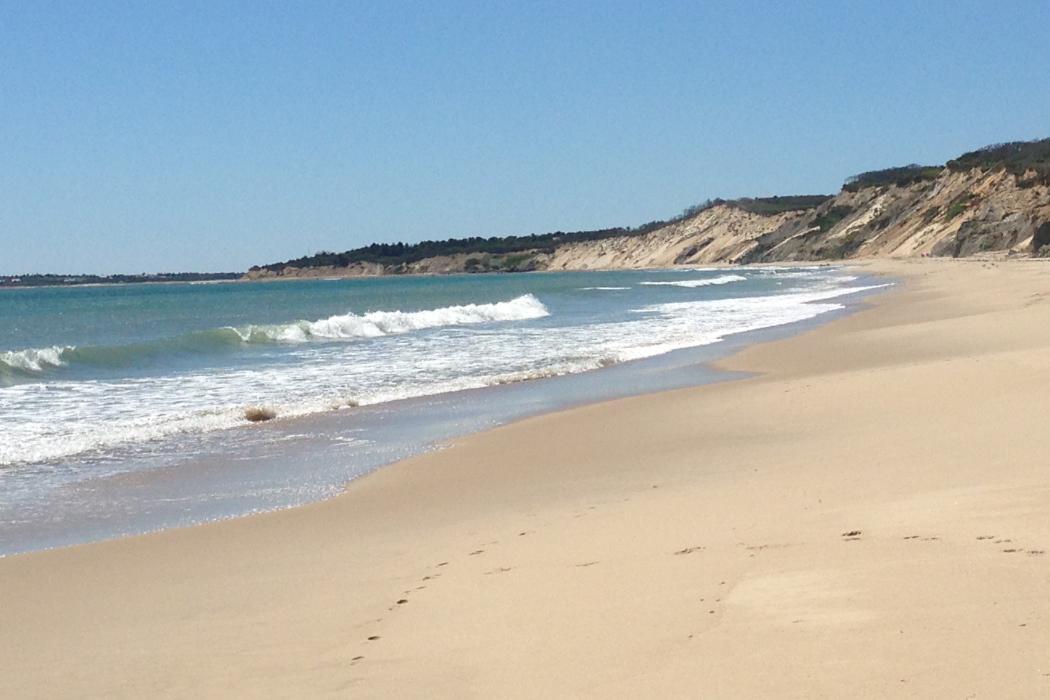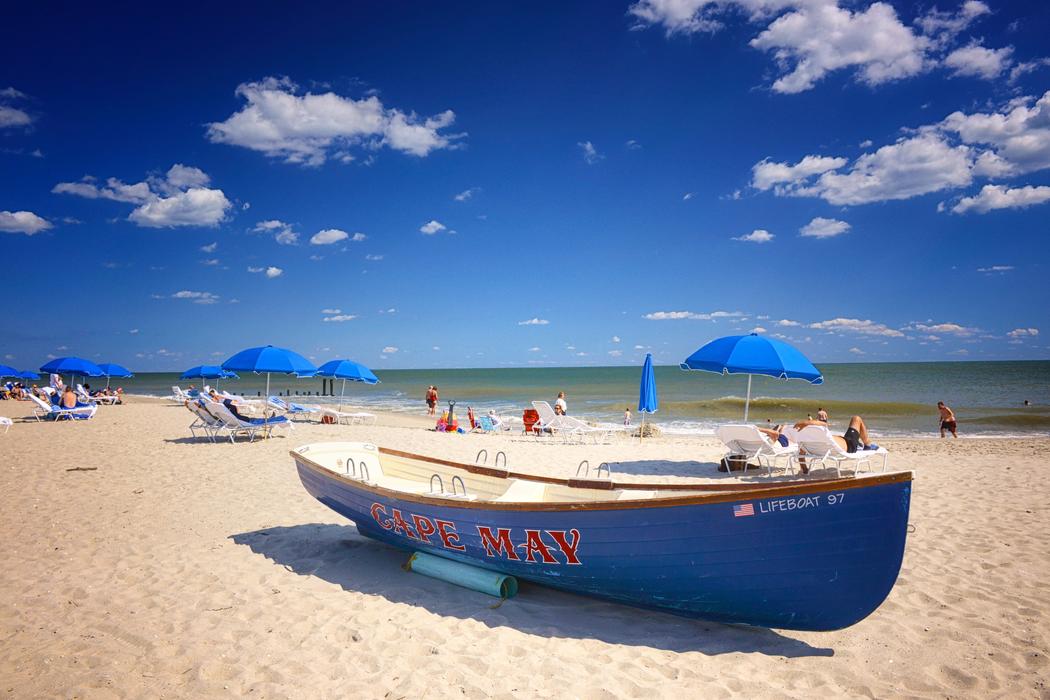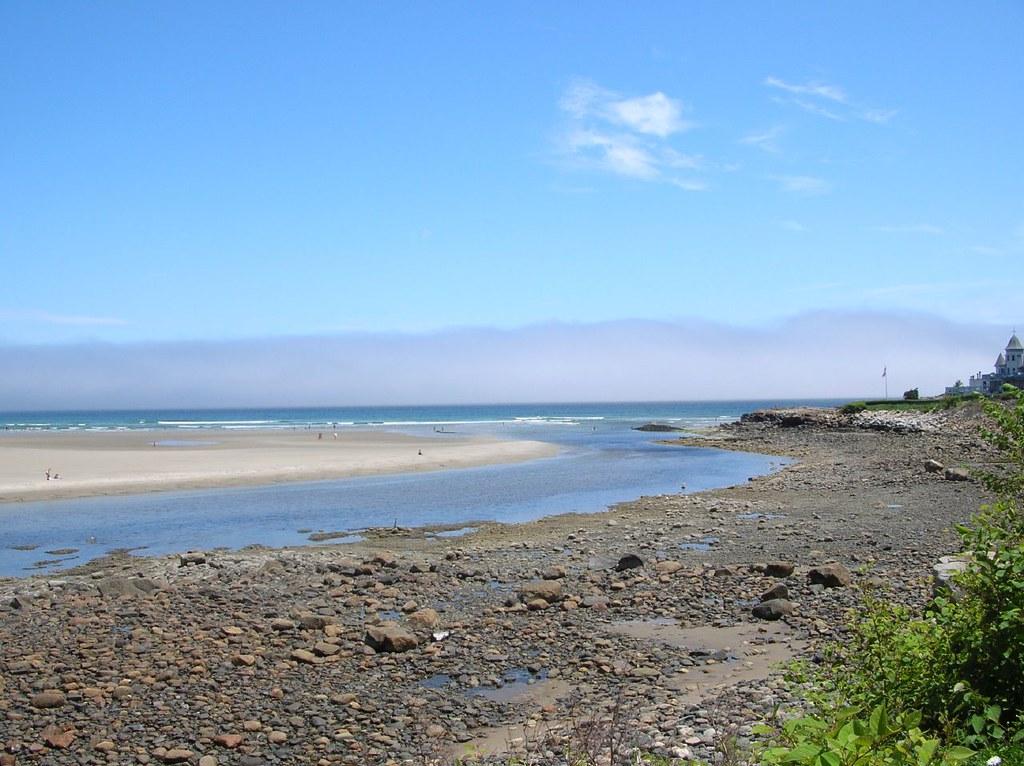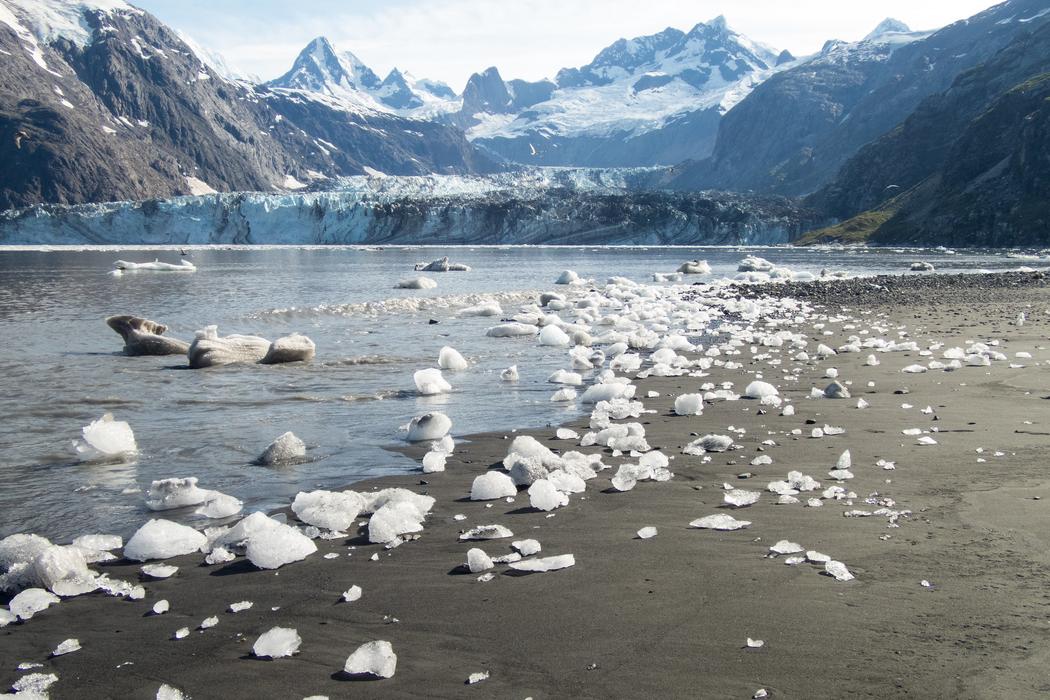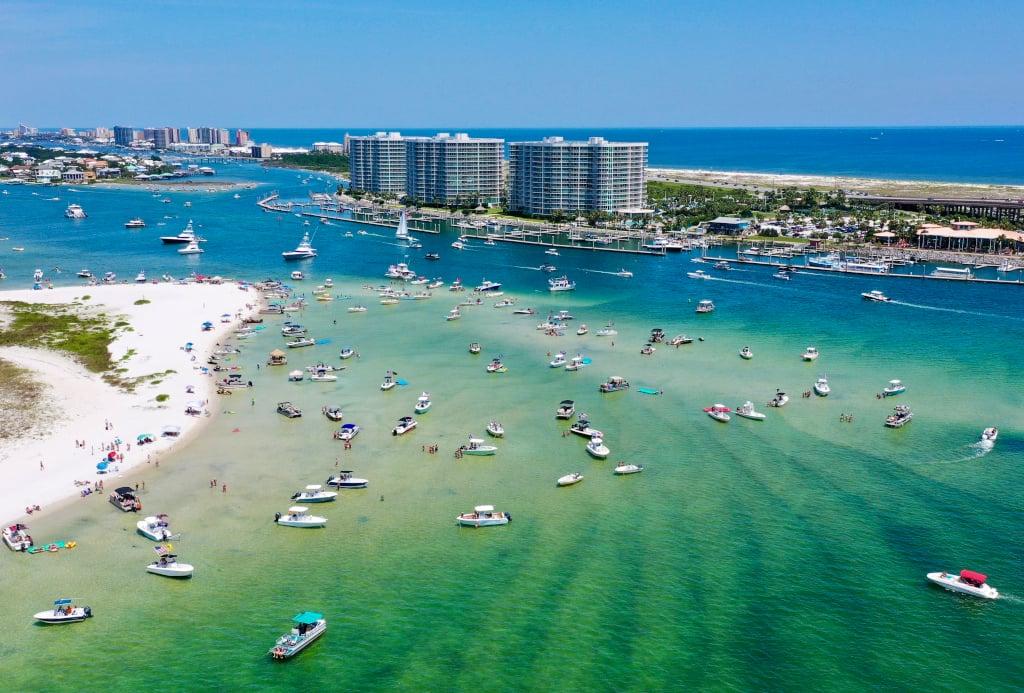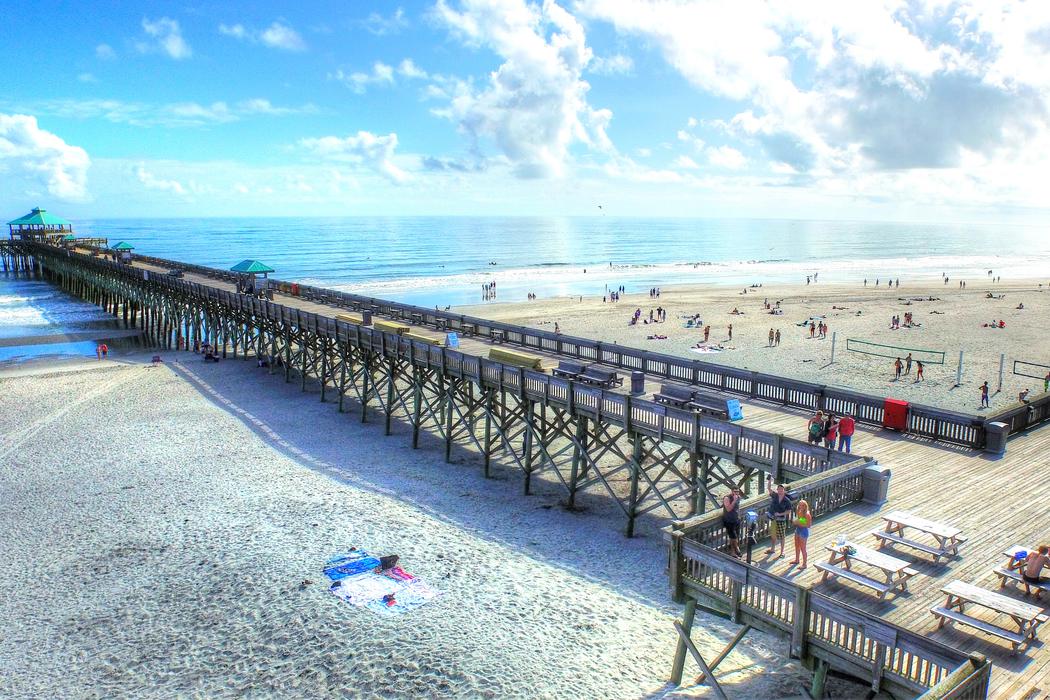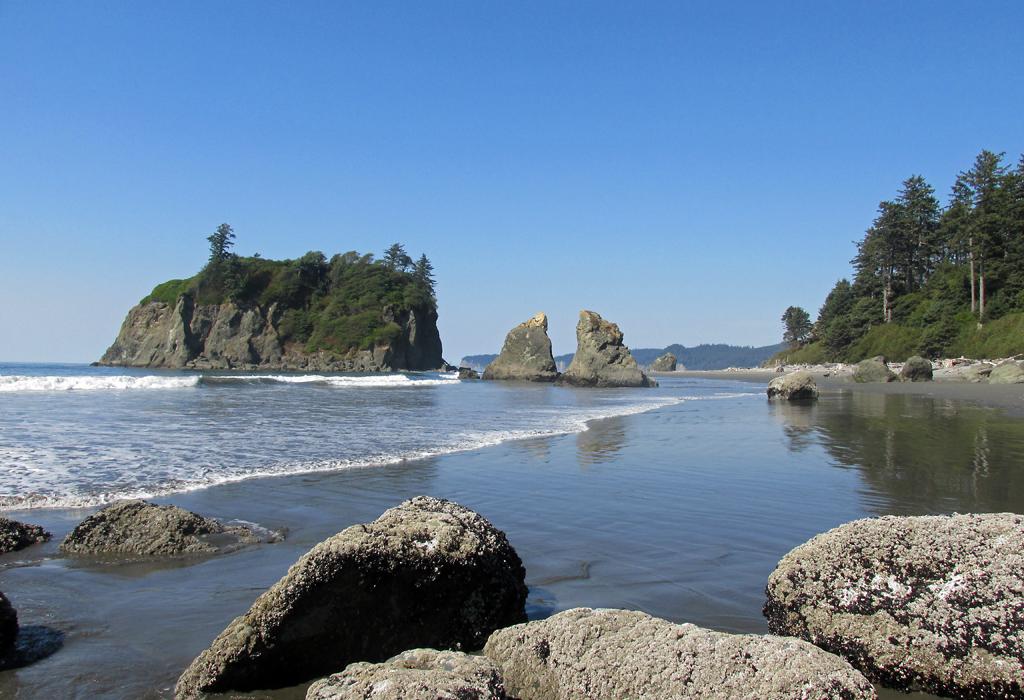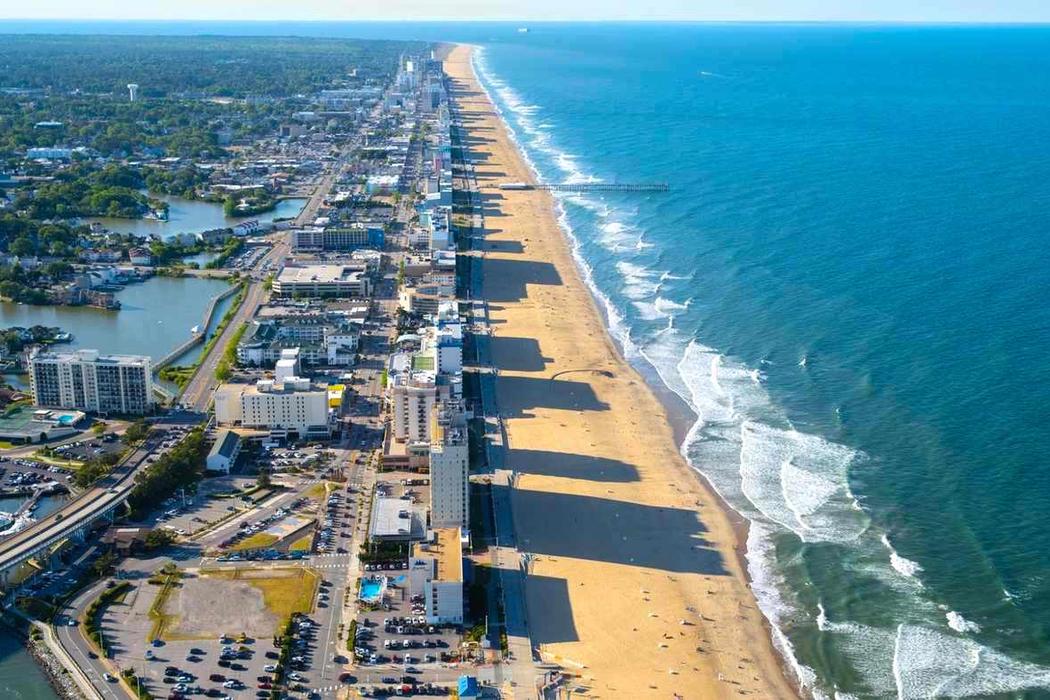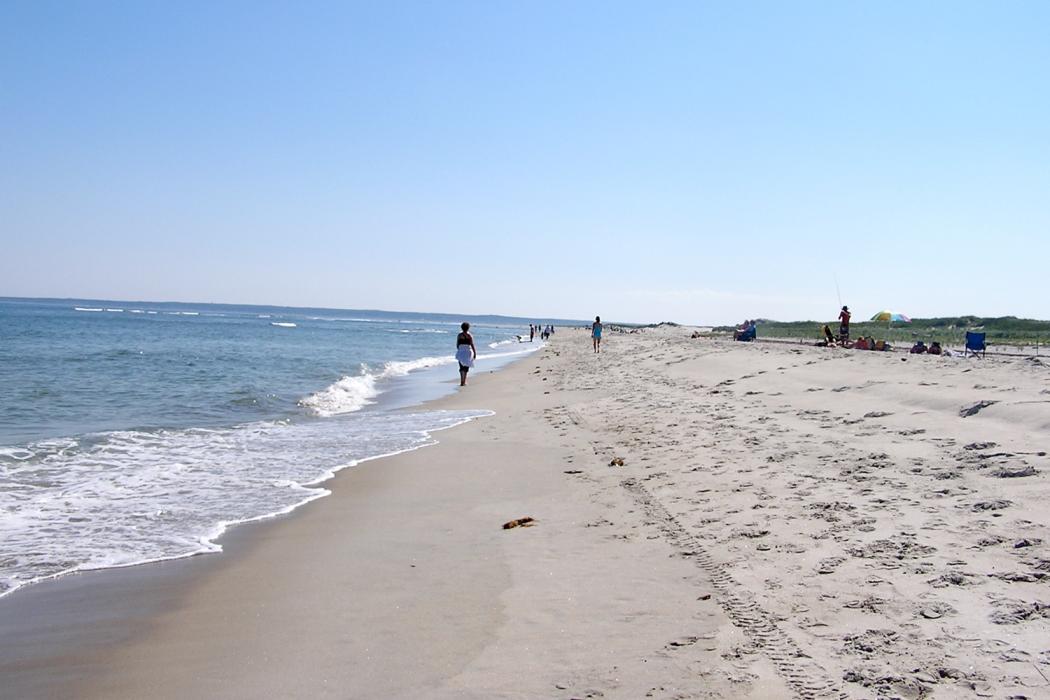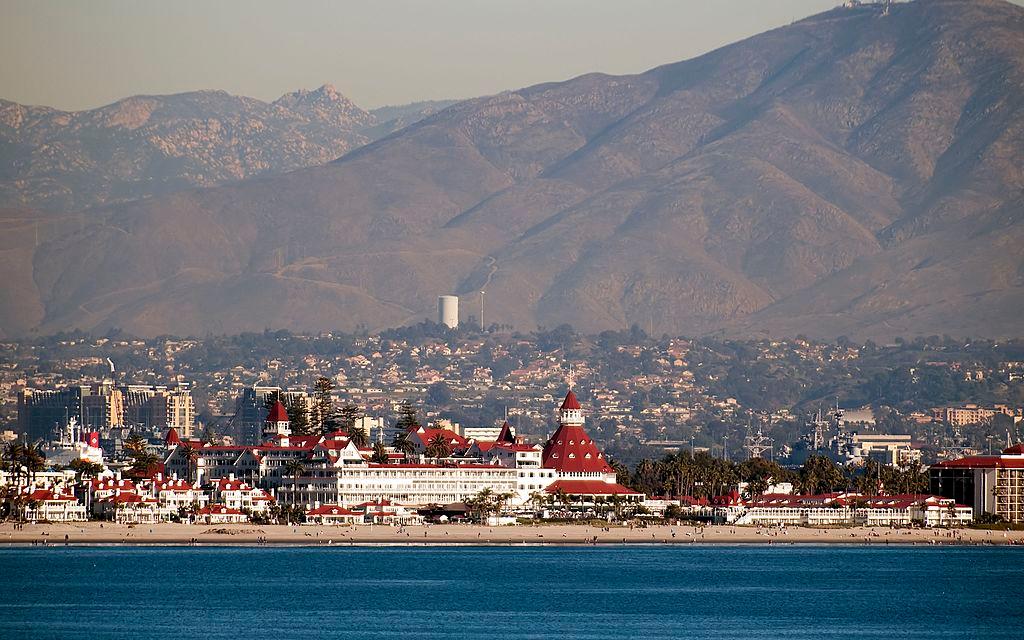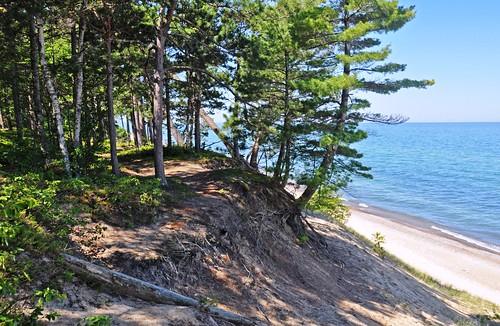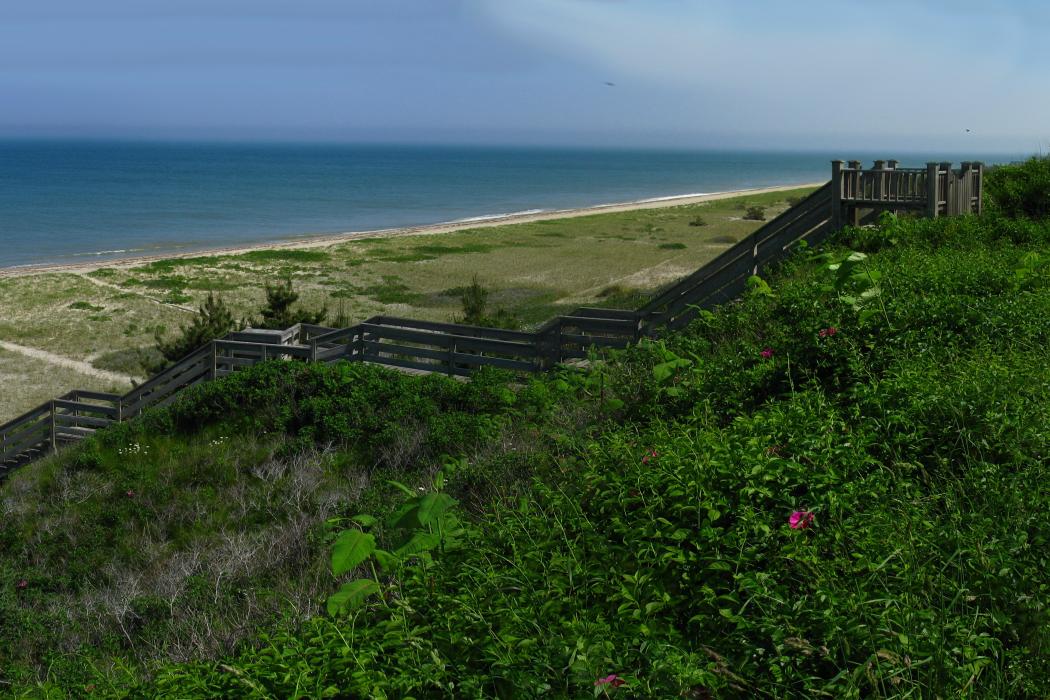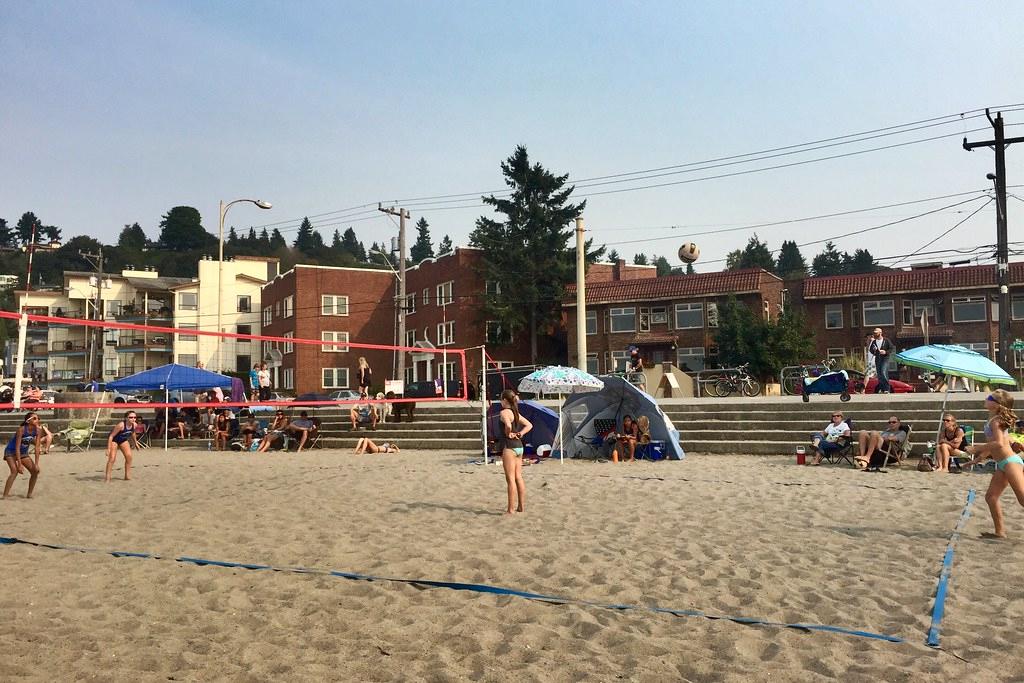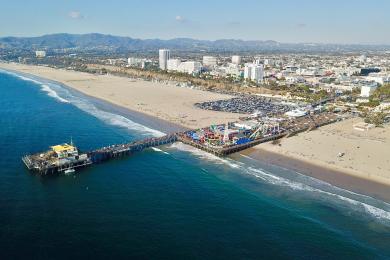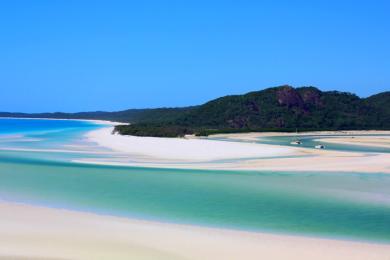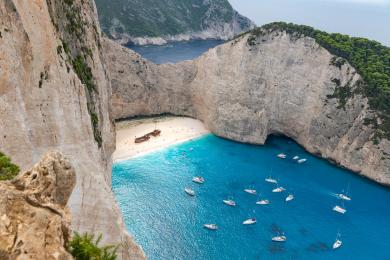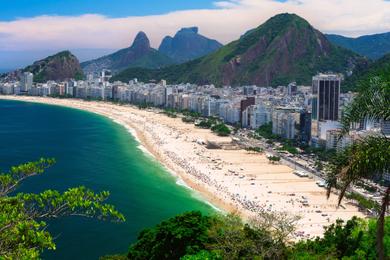We’ve all heard of Miami’s South Beach. Featured heavily in iconic films such as Scarface, Miami Vice, Baywatch, Goldfinger, and Ride Along, it’s one of the world’s most famed and instantly recognizable beaches. With its iconic Ocean Drive, renowned restaurants, luxury shopping, opulent hotels and resorts, and bustling nightclubs, South Beach is possibly the world’s most popular beach destination. Additionally, Miami Beach – South was named theBest Beach in the Top 50 Beaches in the United States list in 2022 by Randall Kaplan, the world's foremost beach expert who is known as "Mr. Beach.”
When you arrive at South Beach, you’ll immediately notice the beach’s incredible views. From the sand, beachgoers marvel at Miami Beach’s skyline. With its art-deco architecture, dramatic modern high-rises, and sky-scraping palm trees, the skyline is arguably South Florida’s most iconic sight.
Once you walk onto South Beach’s glistening golden sand, you’ll see that South Beach is more than just a tourist destination. It’s a naturally stunning beach in its own right. With vibrant turquoise water and glistening golden, it’s the perfect place to lounge and enjoy nature while just steps from the big city. While you’re there, be sure to catch South Beach’s vibrant sunsets, which peak at around 7 pm.
Located in the Oregonian city of Cannon Beach, the beautiful Cannon Beach is a large four-mile-long beach with light brown sand. Cannon Beach has been named the 2nd Best Beach in the Top 50 Beaches in the United States list in 2022 by Randall Kaplan, the world’s foremost beach expert who is known as "Mr. Beach." Portions of this popular beach are situated below oceanfront bluffs. This beach has a magnificent backdrop of oceanfront hills and residential houses. Many offshore rock formations are present in the water near Cannon Beach and the most iconic offshore rock formation along the Cannon Beach shoreline is a 235-feet tall intertidal basalt sea stack named Haystack Rock - this rock is the third largest intertidal rock formation in the world. This beach was named as the sixth best beach in the United States by TripAdvisor’s Travellers’ Choice awards in 2020. In addition, the beach was also listed by the travel division of the American media company U.S. News & World Report as one the 27 best beaches in the United States. Renowned academic Dr. Stephen Leatherman has listed Cannon Beach as the "Best Overall Beach" in Oregon in his book America’s Best Beaches. The city of Cannon Beach was also listed by National Geographic as one of "America’s Best Beach Towns." A creek occasionally flows through the beach into the Pacific Ocean. As an interesting fact, the beach and the city of Cannon Beach are named after a cannon from the 19th century United States Navy schooner Shark - this cannon was discovered near Cannon Beach’s current location in 1898 and it sparked the name change of the city from "Elk Creek" to "Cannon Beach."
Located in the city of Venice in Southern California, Venice Beach – also known as Venice City Beach - is an extremely popular three-mile long beach that has light brown sand and rocky breakwaters. This beach is very large – approximately 238 acres in size. The southern portion of Venice Beach is known as Venice Pier Beach- this portion received this name because it has a 1,300-feet long pier named the Venice Pier that is also known as Venice Fishing Pier. Venice Beach has been named the 3rd Best Beach in the Top 50 Beaches in the United States list in 2022 by Randall Kaplan, the world's foremost beach expert who is known as "Mr. Beach.” (Please note that Venice Beach in California should not be confused with another popular beach in the United States named Venice Public Beach, which is also known as Venice Beach) that is located in Sarasota County in Florida.)
Venice Beach hosts many sporting events, and two of them – skateboarding and 3x3 basketball – will be held there during the 2028 Summer Olympics. Venice Beach has lifeguards from 8 am to sunset (that usually occurs around 6 pm) - during summers, lifeguards here are posted from 7 am till sunset (that occurs around 8:30 pm). In addition to lifeguards, Venice Beach and the area around it offer many other amenities including picnic areas, restrooms, showers, bike rental facilities, a bike path, grassy recreational areas, paddle tennis courts, basketball courts, skateboarding, volleyball courts, handball courts, walking paths, nearby watersports equipment rental facilities, and a kids’ play area. Dogs are not allowed on Venice Beach.
Located in Honolulu, Waikiki Beach is a beautiful and extremely popular beach with light brown sand and nearby palm trees. This beach is located in the popular touristy neighborhood of Waikiki. The beach’s name in Hawaiian means "spouting water" - the beach received this name because in the past multiple springs and rivers used to flow around this beach – as another fun fact Waikiki Beach was used by Hawaiian nobility for surfing. Waikiki Beach is one of the most famous beaches in the United State and was named the 4th Best Beach in the Top 50 Beaches in the United States list in 2022 by Randall Kaplan, the world’s foremost beach expert who is known as "Mr. Beach.” It is important to note that Waikiki Beach is a part of a larger beach area that stetches for almost two miles that is also called Waikiki Beach – in addition to Waikiki Beach, this larger beach area is composed of seven other beaches including Duke Kahanamoku Beach (also called Kahanamoku Beach and Duke Paoa Kahanamoku Beach Park), Fort DeRussy Beach (also known asFort DeRussy Beach Park, Gray’s Beach (also known as Grays Beach, Halekulani Beach, Kawehewehe, and Grey’s Beach), Royal Hawaiian Beach (also known as Waikiki Beach Center and Royal Moana Beach), Kuhio Beach (also known as "The Ponds", Kuhio Ponds, and Kūhiō Beach), Queen’s Beach (also known as Queen Kapiolani Beach , Queen’s Surf Beach, and Kapiolani Beach Park), and Kaimana Beach (also known as also known as Kaimana Beach Park, Kaimana’s Beach, Waikiki at San Souci Beach, Sans Souci Beach, and San Souci Beach).
Waikiki Beach is constantly threatened by erosion – some of Waikiki Beach’s parts have been significantly reduced in size due to erosion. There are multiple rocky jetties and seawalls near Waikiki Beach – the beach’s southwestern portion particularly has many rocky seawalls near it. Although most of the portions of Waikiki Beach have lifeguards, there are some portions that do not have lifeguard deployment – these portions are located near 2055 Kalia Road, in front a hotel named the Halekulani Hotel, and adjacent to another hotel named Hilton Hawaiian Village Waikiki Beach Resort. In addition to lifeguards,
Located along Florida’s central coastline, Clearwater Beach is an immensely popular beach that has soft white sand. This wide beach is situated in Pinellas County and spans over two-and-a-half miles. Clearwater Beach’s reputation as one of the United States’ premier beach destinations is not simply a tall claim - the beach has received many accolades from travel websites and media publications. The beach has been named the 5th Best Beach in the Top 50 Beaches in the United States list in 2022 by Randall Kaplan, the world's foremost beach expert who is known as "Mr. Beach" - and was also featured by Tripadvisor’s Travellers Choice awards in 2016, 2018, and 2019. USA Today also listed Clearwater Beach as the "best beach town in Florida" in 2013. A 1,000 feet-long concrete pier named Pier 60 is also present in Clearwater Beach
Pfeiffer Beach also featured in USA Today's list of Top Ten Beaches in California in 2015 and countless other lists on travel planners. Moreover, it is popular among pet lovers as it allows dogs on leash and is one of the few beaches in the Big Sur region to do so. If you are planning to go into the water near Pfeiffer Beach, we recommend being extremely careful and preferably wearing a wetsuit as the water here is extremely cold and is known for dangerous rip currents. Moreover, between May and July, this part of the Big Sur coastline becomes extremely foggy (a phenomenon known locally as the "June Gloom") which can make navigation difficult while in the water near Pfeiffer Beach. Nevertheless, you can stay on the beach and observe a variety of animals present in the water here including seals, sea lions, dolphins, and migrating grey whales (between December and April). You can also explore the tide pools present on the northern side of the beach during low tides which contain a variety of animals including crabs, mollusks, and sea urchins. You can also explore the various interesting rock formations present around the beach shoreline. Pfeiffer Beach is a popular spot among photographers for its unique geographical features. We recommend visiting this beach at around sunset as during this time sun rays seem to pass through the natural tunnel at Keyhole Arch, presenting a beautiful illusory effect.
Sleeping Bear Dunes National Lakeshore, located in Glen Arbor, Michigan, is a stunning natural wonder that offers breathtaking landscapes and diverse activities. The park encompasses a 35-mile stretch of Lake Michigan's shoreline, including North and South Manitou Islands, and features towering sand dunes, pristine beaches, and ancient forests. Established in 1970, it is renowned for its natural beauty and rich cultural heritage, earning it the title of 'The Most Beautiful Place in America' in 2011. Visitors can enjoy hiking, kayaking, and exploring historic sites like the 1871 South Manitou Island Lighthouse. The park's unique features include the Dune Climb, a 284-foot tall dune offering panoramic views, and the Sleeping Bear Heritage Trail, a 20-mile multi-use path. With its blend of natural beauty and historical significance, Sleeping Bear Dunes National Lakeshore is a must-visit destination for outdoor enthusiasts and history buffs alike. The area's scenic beauty and recreational opportunities make it an ideal location for families and adventure seekers, with activities ranging from swimming and beachcombing to stargazing and wildlife watching.
Read More...Poipu Beach, located in Koloa, Hawaii, is a picturesque destination known for its family-friendly atmosphere and diverse marine life. The beach offers a shallow, protected swimming area perfect for children and snorkeling enthusiasts alike. It is surrounded by lush greenery and offers stunning views of the ocean, making it a popular spot for both locals and tourists. The area is rich in amenities, including nearby restaurants, hotels, and attractions that cater to a wide range of interests and preferences. The beach itself is a haven for those seeking relaxation and adventure. Visitors can enjoy swimming, snorkeling, or simply basking in the sun. The nearby Poipu Beach Park provides additional amenities such as picnic areas and playgrounds, enhancing the overall experience for families. The area is also home to a variety of wildlife, including sea turtles and monk seals, which can often be spotted in their natural habitat. Poipu Beach is part of the larger Kauai landscape, offering easy access to other scenic spots and outdoor activities like hiking and surfing. Its proximity to local shops and dining options makes it an ideal base for exploring the island's unique culture and natural beauty.
Read More...Hanalei Bay, located on Kauai's North Shore, is one of the best beach locations in all of the Hawaiian islands, with verdant mountains, spectacular surf breaks, and timeless waterfalls. Beautifully-blue waters and golden sand add to this picturesque location, making it one of the most popular beaches in the U.S.A.
Channel your inner soul-surfer and ride one of the powerful waves on the far right side of the bay. You can also snorkel along one of the many coral reefs throughout the beach, including Waikoko Reef on one side and Pu'u Poa Reef on the other. Hanalei Pier is located on the mouth of the river where the calmest waters are found -- perfect for young children. You can kayak along the river and camp at the park nearby, complete with full amenities.
After a jam-packed beach day, it's time for some good eats and an ice-cold beverage. Hanalei's food truck network includes juice bars, island wraps, acai bowls, and more, giving the bay a unique dining scene and laidback island vibe. Kealia Poke is the new fad on the island, along with the refreshing Wishing Well Shave Ice. One thing that makes the island so carefree is the commitment to authenticity and the refusal to give in to tacky tourist attractions. For example, you'll never see a chain restaurant at Hanalei Bay -- only mom-and-pop shops are scattered throughout the island. Free of typical brand names and tacky souvenirs, you'll feel like a local yourself! Enjoy your stay at Hanalei Bay, a beachy heaven that will leave you on a breezy, tropical Cloud Nine.
Located in the city of Gulf Shores in Alabama, Gulf Shores Main Public Beach – also known as Gulf Place West and East Beach, Gulf Place, and Gulf Shores Public Beach – is a large and popular white-sand beach. This beach was listed as one of the 25 best beaches in the United States by the Travel+Leisure magazine. It was also listed as one of the “The Best Beaches Near New Orleans You Can Drive to This Summer” by the online media website Thrillist, and is a favorite of Randall Kaplan, the world’s foremost beach expert who is known as Mr. Beach.
El Matador Beach, located in Los Angeles County, is one of three beaches that make up the Robert H. Meyer Memorial State Beach (the other two are El Pescador Beach and La Piedra Beach). Nestled along the scenic Pacific Coast Highway, El Matador Beach, or “El Mat,” is known for its picturesque rock formations, golden sands, and is located below dramatic oceanfront bluffs that are lined with very expensive multimillion-dollar homes that, in some cases, exceed $30 million.
The beach has been named as the 11th best beach in “Top 50 Beaches of the United States” list in 2022 by Randall Kaplan, the world’s foremost beach expert who is known as “Mr. Beach.” Managed by the California Department of Parks and Recreation, El Matador Beach is also celebrated by Lonely Planet as one of the top beaches in the U.S., and it’s often recognized as one of Los Angeles’s best beaches. Visitors can enjoy the beach daily from 8 am until sunset.
Located in the city of Myrtle Beach, Myrtle Beach State Park is a 312-acre state park that has a wide white sand beach which is approximately a mile long. A maritime forest and sand dunes are present near the beach. The beach also has a pier named Myrtle Beach State Park Pier. A creek also flows through the beach into the Atlantic Ocean. Myrtle Beach State Park was the first South Carolina State Park, and has been named the 14th Best Beach in the Top 50 Beaches in the United States list in 2022 by Randall Kaplan, the world’s foremost beach expert who is known as "Mr. Beach." Myrtle Beach State Park has lifeguards in its northern portion between mid-May and mid-September.
Santa Monica Beach, located in the city of Santa Monica, is a highly popular 3.5-mile-long beach with light brown sand. This beach, also known as Santa Monica State Beach, is divided into three main sections: Santa Monica Beach - North Beach (which is also known as Santa Monica - North Beach and Santa Monica North Beach), Santa Monica Beach - Pier Beach (which is also called Santa Monica - Pier Beach and Santa Monica Pier Beach), and Santa Monica Beach - South Beach ( which is also called Santa Monica – South Beach, Santa Monica South Beach, and Ocean Park Beach).
Santa Monica Beach—North Beach is quieter, offering a more peaceful experience, while Pier Beach is at the center and features the iconic Santa Monica Pier. Santa Monica Beach - South Beach, also referred to as Ocean Park Beach, is situated to the south of the pier.
Santa Monica Pier, stretching 1,650 feet, is a well-known landmark and draws millions of visitors annually. It is an iconic pier that was initially opened in 1909 and has been designated as a Santa Monica Historic Landmark - this pier offers a large variety of things to do including a popular amusement park named Pacific Park that has the world’s only solar-powered Ferris wheel, fun rides for kids (including a 1920s carousel), an arcade, an aquarium at the end of the pier named Heal The Bay Aquarium, and interesting concessions and shops. If you are planning to fish from the Santa Monica Pier or from any part of Santa Monica State Beach, please follow the local fishing regulations that can be found on the website of California Department of Fish and Wildlife.
Santa Monica Beach is also frequented by snorkelers and scuba divers, and visitors may spot wildlife such as seals, sea lions, and migrating whales at certain times of the year. If you’re into biking or skating, the Ocean Front Walk (also called the Santa Monica Boardwalk) offers a scenic path with oceanfront views and passes by various restaurants and shops. The North Beach Trail section includes unique artwork inspired by local plant and animal life. A portion of another famous biking trail named the Marvin Braude Bike Trail (also known as The Strand) is also located along Santa Monica State Beach - this popular 22-mile oceanfront biking, jogging, and roller-skating trail mostly runs parallel to the coastline of the Santa Monica Bay.
Located in
the city of Destin, Destin Beach is a beach with white sand.
Located in the north-western part of the Oregon shoreline, Rockaway Beach is a large beach that has light brown sand. The beach is situated in the city of Rockaway Beach and it also has a fantastic background of oceanfront hills and buildings. Multiple creeks also flow through the beach into the Pacific Ocean. An interesting 88 feet-tall offshore rock formation named the Twin Rocks is also present in the water near this beach - this amazing rock formation is composed of sandstone and is millions of years old. In addition, the rock formation also plays an interesting role in influencing the local coastal geography by changing the shape of the beaches near it. Rockaway Beach has also been named the 15th Best Beach in the Top 50 Beaches in the United States list in 2022 by Randall Kaplan, the world’s foremost beach expert who is known as "Mr. Beach" – and has been listed as one of the best beaches and beach towns in coastal Oregon by the online media website Thrillist.
Capitola Beach is a popular spot in the charming seaside town of Capitola. Known as California’s oldest resort town, Capitola has a lively atmosphere with a beach that features colorful, Mediterranean-style buildings. Capitola Beach is part of Soquel Cove, a 3.5-mile bay on the eastern Santa Cruz County coast. The beach has been named the 16th Best Beach in the Top 50 Beaches in the United States list in 2022 by Randall Kaplan, the world's foremost beach expert who is known as "Mr. Beach.”
The western side of Capitola Beach has rocks that make the waters calm and perfect for swimming. The eastern side has more waves, which attract surfers. Lifeguards are only present during special events and busy times. Visitors can use restrooms, showers, concession stands, boogie boards, umbrellas, chairs, and seating areas. Dogs are not allowed on Capitola Beach.
Located in the town of East Hampton in the state of New York, Main Beach – also called East Hampton Main Beach – is a popular and large beach with beige sand. This beach was listed as the third best beach on the Eastern Coast of the United States by Town & Country magazine’s “Top 15 Beaches On The East Coast” list in 2018. In addition, Main Beach was also listed as the 17th Best Beach in the “Top 50 beaches in the United States” list in 2022 by Randall Kaplan, the world’s foremost beach expert who is also known as Mr. Beach.
Emerald Isle Beach, located on the western end of Bogue Banks in North Carolina, is renowned for its pristine beaches and family-friendly atmosphere. The beach is part of the Crystal Coast, offering stunning emerald-green waters and soft white sand. It has been voted as one of the best beaches in North Carolina and the South, attracting thousands of tourists each summer. The area is rich in history, having been inhabited by Native Americans and later developed into a thriving beach town. Visitors can enjoy a variety of activities, including swimming, fishing, and water sports, making it a perfect destination for both relaxation and adventure. The beach is lined with homes, duplexes, and condominiums, providing ample accommodation options for visitors. Additionally, Emerald Isle is known for its excellent fishing spots and is a nesting site for protected sea turtles. The town's development has been carefully managed to maintain its natural beauty and family-oriented vibe. With its beautiful beaches and abundant wildlife, Emerald Isle offers a unique blend of natural beauty and recreational activities, making it a cherished vacation spot for families and nature lovers alike.
Read More...Located in the borough of Brooklyn, Coney Island Beach is a large and immensely popular light-brown sand beach that has rocky groynes along its shoreline. This beach is situated in the popular neighborhood of Coney Island and has been named the 19th Best Beach in the Top 50 Beaches in the United States list in 2022 by Randall Kaplan, the world’s foremost beach expert who is known as "Mr. Beach". An 80-feet long boardwalk is also present near the beach - this boardwalk is also known as the Coney Island Boardwalk or the Riegelmann Boardwalk and it was listed as one of the "Top 10 U.S. Boardwalks" by the National Geographic magazine.
Located near Corpus
Christi on the Gulf of Mexico, Malaquite Beach is an approximately four-mile-long
scenic beach with white sand and nearby sand dunes in Padre Island. This beach is a part of a national park named
Padre Island National Seashore.
Malaquite
Beach has been named the 20th Best Beach in the “Top 50 Beaches in the United
States” list in 2022 by Randall
Kaplan,
the world’s foremost beach expert who is known as “Mr. Beach” – and was also
listed by Travel + Leisure magazine
as one of the “The Best Texas Beaches for Every Kind of Traveler” in 2023.
Located in the city of Delray Beach, Delray Municipal Beach - also known as Delray Public Beach and Delray Beach Municipal Beach - is a popular large and clean white-sand beach with nearby palm trees. Many kinds of plants are also present around Delray Municipal Beach including beach stars, necklace pods, and sea grapes. Delray Municipal Beach was named the 22nd Best Beach in the Top 50 Beaches in the United States list in 2022 by Randall Kaplan, the world's foremost beach expert who is known as "Mr. Beach.” This one-and-a-half-mile-long beach was listed by Travel Holiday magazine as one of the top beaches in the South-eastern United States.
Located on the island of Maui, Kaanapali Beach – also known as Ka’anapali Beach – is a long and popular beach with light brown sand. Kaanapali Beach has been named the 23rd Best Beach in the Top 50 Beaches in the United States list in 2022 by Randall Kaplan, the world’s foremost beach expert who is known as “Mr. Beach” – it was also listed by the Condé Nast Traveller as one of the 10 best beaches in Maui and was listed as one of the best beaches in the US by TripAdvisor’s Travellers’ Choice awards.
Located in the resort town of Ocean
City, Ocean City Beach – also known as OC Beach – is a 10-mile-long and large beach with
light brown sand with a rocky jetty near its southern end. Ocean City Beach was named the 24th Best
Beach in the Top 50 Beaches in the United States list in 2022 by Randall
Kaplan, the world’s foremost beach expert who is known as Mr. Beach. This beach was listed as the 10th best beach
in the United States by TripAdvisor’s Travellers’ Choice award in 2017
and it was also listed as one of the 16 best beaches in Maryland by Travel+Leisure
magazine.
Lighthouse Beach, located at the southern tip of Sanibel Island, Florida, is a picturesque destination known for its crystal-clear waters, pristine white sand, and historic lighthouse. The beach offers a serene atmosphere, perfect for activities like swimming, shelling, and fishing. Visitors can enjoy the beautiful sunsets and explore the surrounding nature trails. The beach is also a haven for wildlife enthusiasts, with frequent sightings of dolphins and various bird species. The Sanibel Lighthouse, built in 1884, serves as a stunning backdrop for photos, though it is not open to the public for climbing. The beach is well-maintained, with clean facilities and a pet-friendly policy, making it an ideal spot for families and nature lovers alike.Lighthouse Beach is part of a larger nature preserve, ensuring that the environment remains protected and unspoiled. The area is popular for its shelling opportunities, with over 100 varieties of seashells available. The nearby Sanibel Fishing Pier offers a great spot for fishing and sunset viewing. Overall, Lighthouse Beach combines natural beauty with recreational activities, making it a must-visit destination on Sanibel Island.For those interested in exploring beyond the beach, Sanibel Island offers a variety of cultural and outdoor activities, including biking, bird watching, and visiting the nearby Ding Darling Wildlife Refuge.
Read More...Located near the
neighborhood of Streeterville in Chicago, Oak Street Beach is a popular small
beach with light brown sand, a gradual sloping incline, and a backdrop of
high-rise buildings along Lake Michigan.
Oak Street Beach has been listed as one
of the “The 25 Best Chicago Beaches” by Time
Out Chicago, has been listed as one of the “25 Best Beaches in the USA” by Travel + Leisure magazine, and was named
the 22nd best beach in the United States by Randall Kaplan, the world’s
foremost beach expert who is known as Mr. Beach.
Located in the city of Naples, Naples Municipal Beach - also known as Naples Beach - is a large beach with white sand with an amazing background of palm trees. A 1,000-feet long pier named the Naples Pier is also present on the beach. While Naples Municipal Beach does not have lifeguards, the city has a Beach Patrol Division which constantly patrols the beach and is trained to help out distressed visitors. Naples Municipal Beach has been named the 27th Best Beach in the Top 50 Beaches in the United States list in 2022 by Randall Kaplan, the world's foremost beach expert who is known as "Mr. Beach.”
Located along the Georgian shoreline, Driftwood Beach is a large white-sand beach with lots of driftwood in Jekyll Island. This beach is situated between a public picnic area named Clam Creek Picnic Area and a hotel named the Villas By The Sea Resort and Conference Center. This exquisite and popular beach was earlier a coastal maritime forest - decades of erosion has resulted in the forest’s tree trunks getting uprooted and being deposited on the beach as driftwood. A creek also flows through the beach into the Atlantic Ocean. This beach has been named the 28th Best Beach in the Top 50 Beaches in the United States list in 2022 by Randall Kaplan, the world’s foremost beach expert who is known as "Mr. Beach" – and was named as the 11th best beach in the United States by TripAdvisor’s Travellers’ Choice awards in 2021. This beach is also widely considered to be one of the most romantic beaches in the United States.
Located on the island of Maui, Waiʻānapanapa State Park is a beautiful oceanfront state park that has multiple unnamed black sand and pebbly beaches. The main beach in Waiʻānapanapa State Park is known as Black Sand Beach and it is also known as Honokalani Beach, and Pa‘iloa Beach. Black Sand Beach was listed by the travel website TripSavvy as one of the world’s best black sand beaches, and Waiʻānapanapa State Park/ Black Sand Beach has been named the 29th Best Beach in the Top 50 Beaches in the United States list in 2022 by Randall Kaplan, the world’s foremost beach expert who is known as "Mr. Beach." The black sand found on Waiʻānapanapa State Park’s beaches is formed from weathered lava fragments and igneous rocks – these black-colored rocks turn into sand due to erosion by wind and water over thousands of years. The beaches in Waiʻānapanapa State Park are present near dense forests. As an interesting fact, the name of the state park means "glistening water" in the Hawaiian language. Many sea cliffs are present near the beaches in Waiʻānapanapa State Park. In addition, a rock arch is also present in the water near Waiʻānapanapa State Park.
Carmel Beach is renowned by both locals and tourists as one of the most spectacular beaches in the world - and for good reason. The beach is an oasis with a backdrop of white sand and turquoise water, and is overlooked by beautiful, grassy hills. The world-class scenic pathway is filled with old, green trees and looks onto the beach. Watching the sunset on the beach is a local tradition - add to the natural romance with a bottle of wine, as alcohol is permitted on specific days of the week. With the gorgeous scenery of Carmel City Beach, you'll be sure to have an unforgettable beach day!
Indiana Dunes State Park is located at the north end of State Road 49 in Porter County, Indiana, offering over three miles of pristine beach along Lake Michigan's southern shore. Established in 1925, it features a diverse landscape with large sand dunes, black oak forests, and button-bush marshes, providing habitats for many plant and animal species[2][3]. Visitors can enjoy swimming, hiking, birding, and camping in this beautiful park[2][4]. The park is part of the larger Indiana Dunes area, renowned for its biodiversity and outdoor activities like cross-country skiing and fishing[1][3]. The dunes themselves have formed over thousands of years, creating a unique ecosystem that attracts nature enthusiasts and scientists alike[2][3]. The park’s proximity to Chicago makes it a popular destination for both local and national visitors, offering a mix of natural beauty and accessibility to urban amenities[2][4]. The park offers facilities like the Nature Center for interpretive programs and a restored Dunes Pavilion for events and dining[2][5].
Read More...Located on a Massachusettsan island named Martha’s Vineyard, Lucy Vincent Beach - also known as Lucinda Vincent Memorial Beach and previously known as Jungle Beach, Blue Mailbox Beach, and Barn House Beach - is a popular beach with white sand, nearby beach grass, and a few rocky portions in the town of Chilmark. The beach is situated below steep oceanfront bluffs. The beach and the shoreline around it are known to have many unique large rock formations - these rock formations are known to be at least thousands of years old. One of the most prominent rock formations of the beach was a naturally-formed rocky spire - this spire was often the subject of many artworks and photographs by local artists and photographers. Unfortunately, this spire collapsed in 2020. Lucy Vincent Beach has been named the 34th Best Beach in the Top 50 Beaches in the United States list in 2022 by Randall Kaplan, the world’s foremost beach expert who is known as "Mr. Beach."
Located in the city of Fort Lauderdale, Fort Lauderdale Beach is a large beach with white sand and palm trees and is next to a beautiful background of oceanfront high-rise buildings. Fort Lauderdale Beach sees fewer visitors than other more popular Florida beaches and this makes the beach have a calm atmosphere. A recreational park named Fort Lauderdale Beach Park is also present near this beach. As an interesting fact, the 1960 movie Where The Boys Are was filmed around Fort Lauderdale Beach.
Fort Lauderdale Beach has been named the 35th Best Beach in the Top 50 Beaches in the United States list in 2022 by Randall Kaplan, the world's foremost beach expert who is known as "Mr. Beach.”
Located on the north-western shoreline of the Hawaiian island of Lanai (also known as Lānaʻi), Polihua Beach is a one-and-a-half mile long and wide beach with pale cream sand. This beach is one of the largest beaches in the island of Lanai. A rocky cliff is present near the northern end of this beach - this cliff is made up of igneous rocks. In addition, many kinds of tropical plants are also present near Polihua Beach. As an interesting fact, the beach’s name in Hawaiian means "eggs in a bosom" or "egg nest" - the beach most likely got its name due to the fact that it used to be a popular nesting site for the Hawaiian green turtle. In addition, the beach was also popular among native Hawaiians as a great sea turtle hunting spot. Polihua Beach was also featured in Hawai’i Magazine’s 2017 article "A Local’s Guide to Hawaii’s Must-See Beaches." In addition, Polihua Beach has been named the 36th Best Beach in the Top 50 Beaches in the United States list in 2022 by Randall Kaplan, the world’s foremost beach expert who is known as "Mr. Beach." Polihua Beach does not have lifeguards or any other amenities except some huts and shelters, so plan your trip accordingly. Getting to Polihua beach can be difficult - the beach is located near the northern end of an extremely long and extremely rugged jeep trail named the Polihua Trail. Driving to the beach takes around an hour from Lanai City and around 30 minutes from an incredibly beautiful rock garden named Keahiakawelo that looks like you could be on the planet Mars. Once you arrive you’ll find a dirt parking lot next to the beach. We recommend carrying water while visiting Polihua Beach because there are no stores or places to stop along the way. We also recommend being careful while visiting Polihua Beach as it is occasionally known to have thirsty wild bees - the best way to avoid these bees is to simply leave some water at a distance in order to divert their attention.
Polihua Beach offers many fun activities including wildlife watching, sunbathing, picnicking, beachcombing, tidepooling, and hiking. Water activities are unsafe in the water near Polihua Beach as it is known to have extremely strong rip currents, considerable and steep depth, and dangerous rogue waves. In addition, drowning-related deaths have also been reported in the water near Polihua Beach. The beach can occasionally also get windy, which often results in visitors having an unpleasant beach visit. Nevertheless, this beach is a great sunbathing spot, especially when the local winds are calm. Depending on the time of the year, you can view many kinds of animals in the water near Polihua Beach including migrating humpback whales (usually between December and April) and sea turtles - while this beach was earlier a popular nesting spot for local sea turtles, it is important to note that sea turtle nesting activity has considerably declined now.
In addition, please also note that while some tourists have been known to drive their vehicles on Polihua Beach, we recommend strictly refraining from doing so as this activity may damage the sea turtle nests on the beach. In addition, vehicles may also get stuck in the sand on Polihua Beach. Polihua Beach is ideal for visitors looking for a quieter beach experience as the beach sees many fewer visitors than most other Hawaiian beaches. If you are planning to fish in the water near Polihua Beach, we recommend following the local fishing regulations. If you like tidepooling, you can explore the interesting tidepools present near the northern end of Polihua Beach. Polihua Beach offers amazing Instagram-worthy views of the Kalohi Channel, the nearby island of Molokai, and distant views of a volcanic tuff cone in the island of Oahu named Diamond Head.
Considered by many to be one of the New Jersey coast’s most popular beaches, Cape May Beach boasts fine golden sand and clear turquoise waters. The beach’s aesthetic is unique, as its long stretches of tree-lined Victorian homes provide an architecturally-striking backdrop to an already stunning beach.
Although popular during the summer, Cape May’s paid beachfront parking lots and street parking make it a stress-free beach to access. When beachgoers arrive at Cape May, they find a variety of amenities that promise to make their beach day one to remember. With showers, changing rooms, restrooms, lifeguard stations, and the Cape May Beach Patrol that protects the beach during summer, Cape May is a comfortable and safe place to sunbathe and spend time with loved ones. In addition to the beach’s swimming areas, there are designated beach areas with ideal conditions that allow thrill-seekers to surf, kayak, fish, and play volleyball freely.
When you’re done with your beach day and want to grab a bite, Cape May’s local restaurants serve top-notch food to locals and visitors alike. Looking for something savory? Head to Lucky Bones Back Water Grills, and order their locally renowned clam pizza. Craving something sweet? The raspberry truffle ice cream at Fine Fellows Creamistry can’t be beaten. And for a drink by the beach, head to Carney’s and grab a locally-sourced craft beer. If you’re planning on spending the night in Cape May, check-in at the ICONA Cape May or the Ocean Club Hotel, two stunning beachfront hotels that, according to past guests, offer large modern rooms and impeccable service.
Located in
the town of Ogunquit on Maine’s southern coast, Ogunquit Beach – also known as
Main Beach and Ogunquit Main Beach – is a large beach with soft white sand. The Ogunquit River also flows near this beach – once this
river passes the beach, it flows into the Atlantic Ocean. This beach has been named the 38th Best Beach
in the Top 50 Beaches in the United States list in 2022 by Randall Kaplan, the world’s foremost beach expert who is known as “Mr.
Beach.” The beach was also named one of
the best beaches in the United States by TripAdvisor's Travelers Choice awards in 2023, and was also listed as one of the
“Best Beaches in New England” by Condé
Nast Traveller in 2020.
Black Sand Beach, nestled in the breathtaking Prince William Sound, Alaska, is a quarter-mile stretch of captivating dark sand. It offers a unique visual experience, with icebergs frequently stranded on the shore. Located where Barry Arm meets Harriman Fjord, this beach is a haven for sea kayakers and campers, providing stunning views of surrounding glaciers and mountains. The beach's proximity to tidewater glaciers makes it a spectacular spot for exploring. At low tide, visitors can walk along the coastline, discovering hidden coves and enjoying the serene beauty of the area. The beach is protected from harsh winds by its geography, making it an ideal spot for paddlers. With its natural allure and lack of conventional beach activities, Black Sand Beach invites visitors to indulge in hiking, photography, and relaxation amidst its tranquil surroundings. The area is rich in wildlife and natural wonders, offering an unforgettable experience for those who venture here.
Read More...Sanibel Causeway Beach is located on a picturesque stretch of soft, white sands in Sanibel, Florida. It spans across the San Carlos Bay, offering stunning views and access to both the bay and the Gulf of Mexico. The beach is part of the Sanibel Causeway, a 3-mile causeway connecting Sanibel Island to the mainland, and features two man-made islands, Island A and Island B. These islands serve as public beaches, offering activities like swimming, fishing, and water sports. The beach is known for its serene atmosphere and lack of high-rise developments, maintaining a natural and peaceful ambiance.
The causeway and its islands are operated by Lee County and offer a range of recreational activities. Visitors can enjoy windsurfing, kitesurfing, and shell collecting, making it an ideal spot for both relaxation and adventure. Nearby, Sanibel Island offers a variety of attractions, including lighthouses, hiking trails, and wildlife refuges.
Despite its natural beauty and recreational opportunities, Sanibel Causeway Beach has limited amenities compared to some other beaches, so visitors often plan ahead. The beach is popular among both locals and tourists seeking a tranquil escape from urban life.
Read More...Located in the Makena Beach State Park, Big Beach stretches over half a mile and is relatively wide compared to surrounding spots, offering plenty of space for everyone. This beach is located in between two black-lava outcroppings which protects it from the winds and offers a stunning view of the small islands Kahoolawe and Molokini. With amenities such as bathrooms, picnic tables, barbecue grills, and food concessions available, Big Beach is the perfect destination for those who want to comfortably enjoy Maui’s amazing nature scene.
The waves at this beach are very large, and they attract lots of boogie boarders and surfers. That being said, be very careful when swimming here, as there are sometimes riptide occurrences that can be dangerous for young children. If in doubt, there are plenty of lifeguard stations on the beach that can inform you of the water conditions. Fishing is another popular activity at this beach, with plenty of spots available along the shore. For adults, you can also access Little Beach from this location, which is a small isolated cove that is a well-known nude beach site.
If you get hungry, Jazzy’s Kitchen is a Mexican food truck that is very popular among locals for their signature fish tacos and quesadillas. It is parked right next to the beach most weekdays and is available for lunch and dinner. We also like Monkeypod Kitchen, a farm-to-table eatery with fresh Hawaiian cuisine and a large list of cocktails and craft beers. You can also take a 9-minute drive to Ko Restaurant, a white-tablecloth seafood eatery run by renowned Chef Tylun Pang.
If you need a place to stay, take an 11-minute drive to Residence Inn by Marriott, a 3-Star all-suite hotel that provides a family-friendly environment and offers amenities such as an outdoor pool and complimentary breakfast. Another excellent option is Grand Wailea Maui, a Waldorf Astoria resort that spans 40 acres along Wailea Beach and sports 9 outdoor pools and a 2000 feet long river with waterslides. You can also take a 9-minute drive to Fairmont Kea Lani, a 5-Star resort located next to the Wailea Golf Club with upscale dining options and a 24/7 fitness facility.
Orange Beach, Alabama, is a vibrant coastal city known for its pristine white-sand beaches and diverse outdoor activities. Located on the Gulf Coast, it offers a perfect blend of relaxation and adventure, with attractions like Gulf State Park and The Wharf. The city is a popular destination for family vacations, offering a range of dining experiences, championship golf courses, and water sports. Its natural beauty, combined with modern amenities, makes it an ideal spot for both leisure and active travelers. The area is home to a variety of wildlife, including alligators and numerous bird species, making it a haven for nature enthusiasts. With its beautiful landscapes and bustling entertainment venues, Orange Beach provides something for everyone. The city's growth and development have made it a hub for events like fishing tournaments and sports championships, further enhancing its appeal as a dynamic vacation spot.
Read More...Located along the Gulf Coast shoreline, Biloxi Beach is a long and popular white-sand beach with multiple breakwaters in the city of Biloxi. The eastern part of this beach is called Biloxi East Beach. In addition, two other parts of this beach are also known as Biloxi West Central Beach and Biloxi Porter Avenue Beach.
Time Out New Orleans listed Biloxi Mississippi Beach as one of the “10 Best New Orleans Beaches That Are a Short Drive Away” in 2024 and Reader’s Digest listed this beach in its article “20 Best Cheap Beach Vacations for Fun in the Sun.” According to an online article by the Southern Living magazine, this beautiful beach has the whitest sand in Mississippi.
Located on the southern end of Kiawah Island, Kiawah Beachwalker Park - also known simply as Beachwalker Park - is a Charleston County-managed park that has a large beach with soft white-sand. Many kinds of plants are present near the beach in Kiawah Beachwalker Park including yucca plants, pines, live oaks, and palmettos. Kiawah Beachwalker Park is the only park with a public-owned beach access on Kiawah Island. Kiawah Beachwalker Park has been named the 46th Best Beach in the Top 50 Beaches in the United States list in 2022 by Randall Kaplan, the world’s foremost beach expert who is known as "Mr. Beach" – and was also named one of the 10 Best Beaches in the U.S in 2017 by Condé Nast Traveler magazine.
Located in the southern part of the Olympic Peninsula in the state of Washington, Ruby Beach is a popular beach with gray sand, a lot of driftwood, some pebbly and rocky parts, and interesting rock formations. This beach is a part of a national park named Olympic National Park. A creek named Cedar Creek sometimes flows through the beach – once this creek passes the beach, it flows into the Pacific Ocean. There is also a large nearby offshore rock formation named Abbey Island. Ruby Beach has been named the 47th Best Beach in the “Top 50 Beaches in the United States” list in 2022 by Randall Kaplan, the world’s foremost beach expert who is also known as “Mr. Beach.” In addition, this beach was also listed as one of the world’s 100 best beaches by Lonely Planet magazine.
Located in the city of Virginia Beach, Virginia Beach Oceanfront - also known as Oceanfront Beach - is a large and extremely popular beach area that has light brown sand. Virginia Beach Oceanfront has a marvelous background of waterfront high-rise buildings. An approximately three-mile long boardwalk named Virginia Beach Boardwalk is present near the beach - this boardwalk was listed by CNN as one of the 19 best boardwalks in the United States. Additionally, Virginia Beach was named the 48th Best Beach in the Top 50 Beaches in the United States list in 2022 by Randall Kaplan, the world's foremost beach expert who is known as "Mr. Beach.” A rocky jetty is also present near the southern end of the Virginia Beach Oceanfront, along with an aquatic inlet named Ruddy Inlet.
Crane Beach, located in Ipswich, Massachusetts, is a stunning four-mile-long sandy beachfront that is part of the larger Crane Estate. It features dunes, a maritime pitch pine forest, and offers five and a half miles of hiking trails. The beach is open year-round and is known for its pristine natural beauty and wildlife, including being a significant nesting site for the threatened piping plover. Visitors can enjoy swimming, kayaking, and exploring the surrounding landscape. The beach has been featured in several films, adding to its allure. The Crane Estate, which includes Crane Beach, Castle Hill, and the Crane Wildlife Refuge, is managed by The Trustees of Reservations, a nonprofit conservation organization. This setup ensures that the area is preserved for both recreation and conservation. The beach offers amenities like restrooms, showers, and a refreshment bar during the summer months. Crane Beach has a rich history, having been gifted by Florence Higinbotham Crane in 1945. It hosts an annual celebration, Crane Beach Day, which began as a tradition by the Crane family in 1911 to celebrate their son's birthday. Today, it remains a beloved event for local school children.
Read More...Located near the San Diego Bay, Coronado Beach - also known as Central Beach and Coronado Central Beach - is a large and flat beach with light brown sand and sparse vegetation. Coronado Beach starts near the historic Hotel del Coronado and spans north along Ocean Boulevard all the way north to a park named Sunset Park. This popular beach is one of the main beaches of the resort-city of Coronado (which is also nicknamed as "Crown City"). Coronado Beach has been named one of the Top 100 beaches in the United States by Randall Kaplan, the world’s foremost beach expert who is known as Mr. Beach. The approximately one-and-a-half miles long beach has a wonderful backdrop of oceanfront residential buildings. The sand in Coronado Beach has a substance named mica, which occasionally causes it to shine. Visitors can encounter this shining sand around the water near Coronado Beach during calm water conditions. The shoreline around this beach also has remnants of a sunken ship named SS Monte Carlo, which was shipwrecked here in the 1930s.
Twelvemile Beach is a stunning stretch of shoreline within Pictured Rocks National Lakeshore in Michigan's Upper Peninsula. Located about 15 miles west of Grand Marais, it offers breathtaking views of Lake Superior and is known for its pristine sand beach and scenic hiking trails. The beach is accessible via the Twelvemile Beach Campground, which provides a rustic camping experience with amenities like picnic tables and fire grates. Visitors can enjoy long walks along the beach, explore the nearby sandstone cliffs, and experience the tranquility of the surrounding wilderness. The area is perfect for nature lovers and those seeking an adventurous getaway. The campground itself is nestled on a sandy bluff overlooking the lake, offering picturesque views and a serene atmosphere.
Read More...Located on a barrier island named Mustang Island, Mustang Island
State Park Beach – also called Mustang Island Beach and Mustang Beach – is a
five-mile-long beach with pale cream sand and nearby large sand dunes. This beach is a part of a 3,954-acre state
park named Mustang Island State Park, and is
usually open between 8 am and 5pm
Located on the island of Nantucket, Siasconset Beach is a long, wide, and beige colored beach situated on the southeastern shore of the island. Siasconset Beach is surrounded by large rocks, sand dunes, and coves making it a secluded spot.
Alki Beach offers a true beach experience in the heart of West Seattle. While most beaches of the Puget Sound are covered with rocks and pebbles, Alki Beach boasts fine, white sand reminiscent of a Southern California beach. There are several beach volleyball courts, grills and fire pits available for use, as well as local vendors offering kayaks and paddleboards for rent. Bring the kids and build some sandcastles or explore the tide pools that form at low tide. A bike path running parallel to the beach is ideal for runners, bikers, and rollerbladers. While playing volleyball or paddling hard out on the water, look east to see the Seattle skyline punctuated by the Space Needle. Even though the bustling city of Seattle looms in the background, Alki Beach boasts a quaint Pacific Northwest charm. Before exploring all that Alki Beach has to offer, stop by Top Pot Doughnuts to grab a coffee and a warm doughnut. After a long day enjoying the beach, grab a pint at West Seattle Brewing Company and watch the sunset over the Puget Sound. History enthusiasts might visit Alki Beach to see what the first settlers to the Pacific Northwest saw, as the Denny party landed on Alki Beach in 1851 before settling in Seattle. After a rainy Seattle winter, there is no better place to enjoy the sun than Alki Beach.
Read More...

